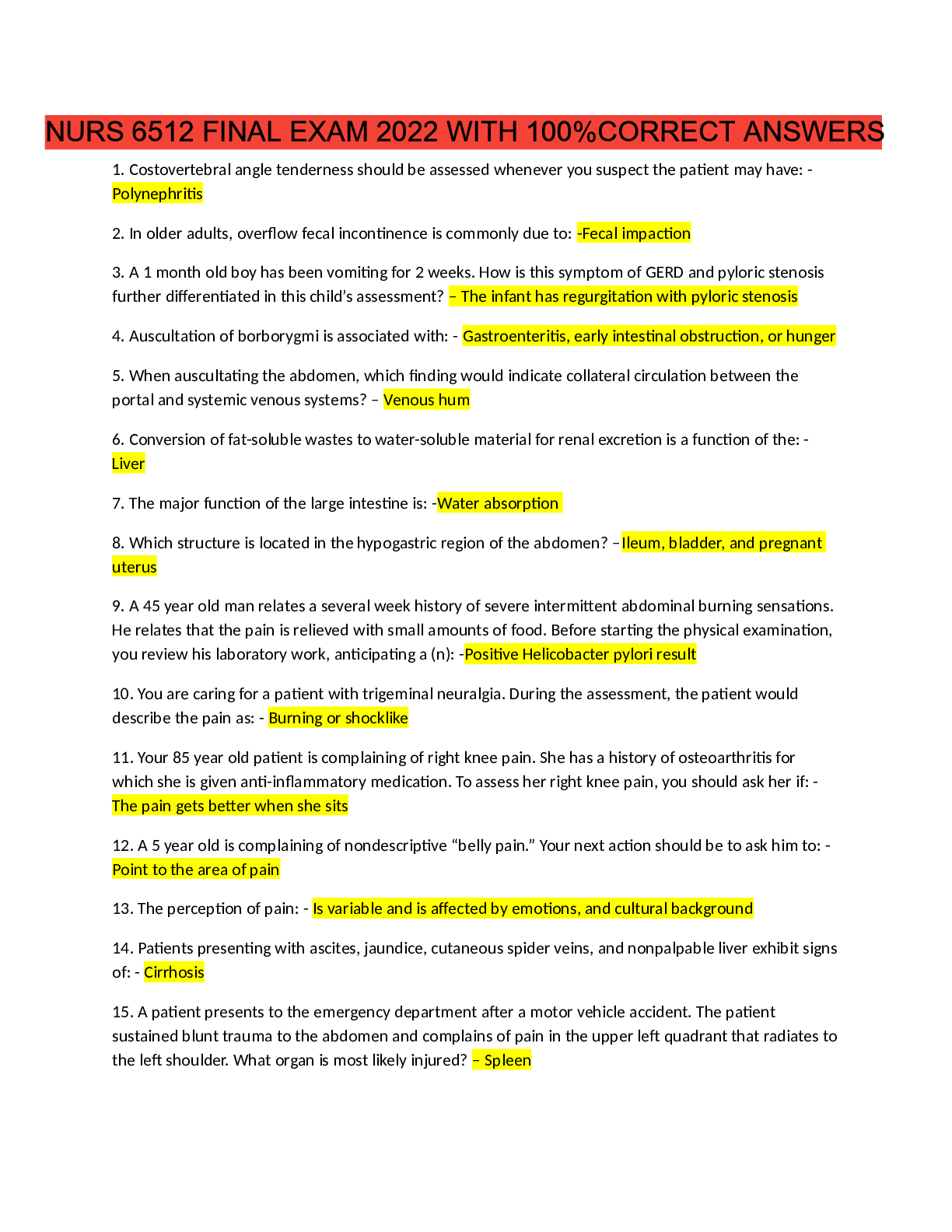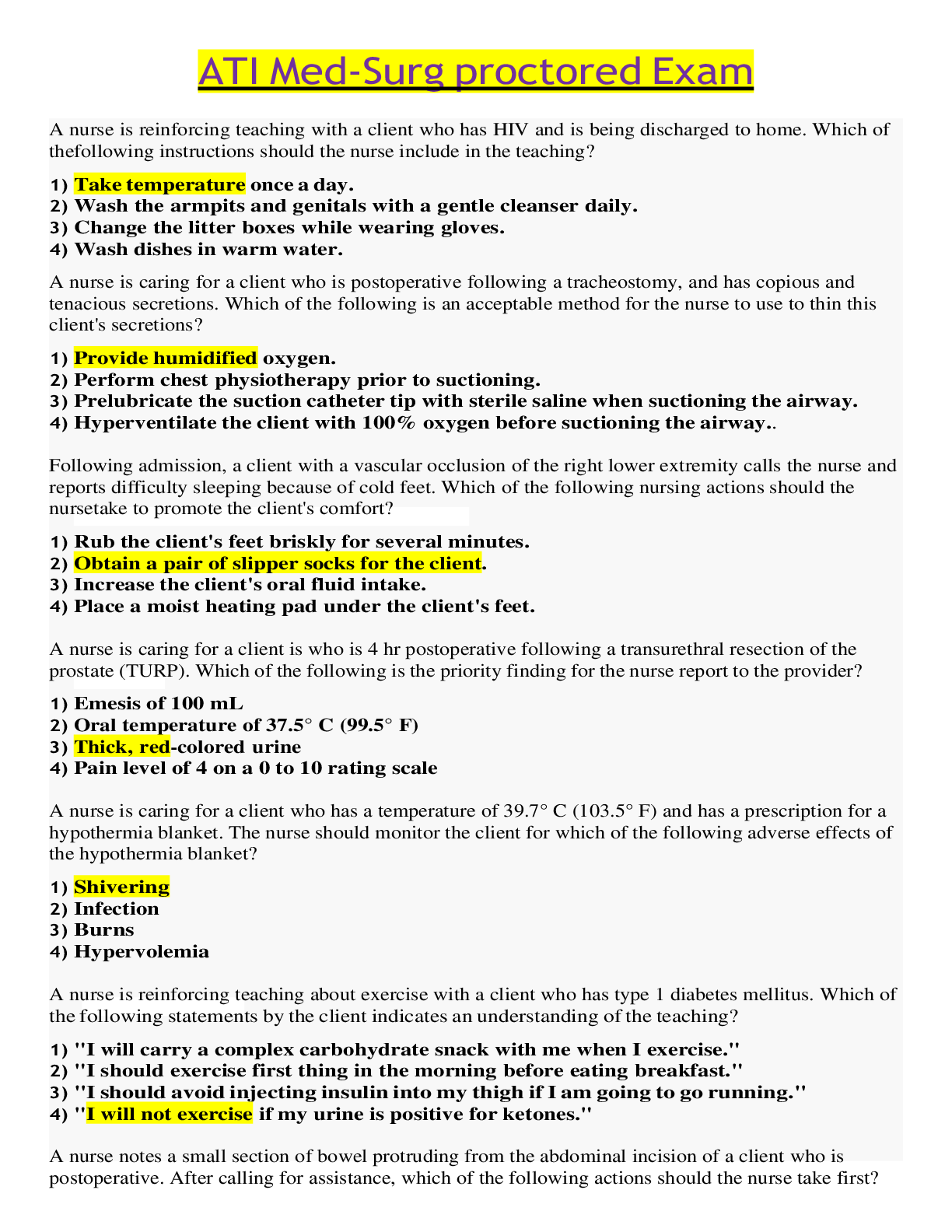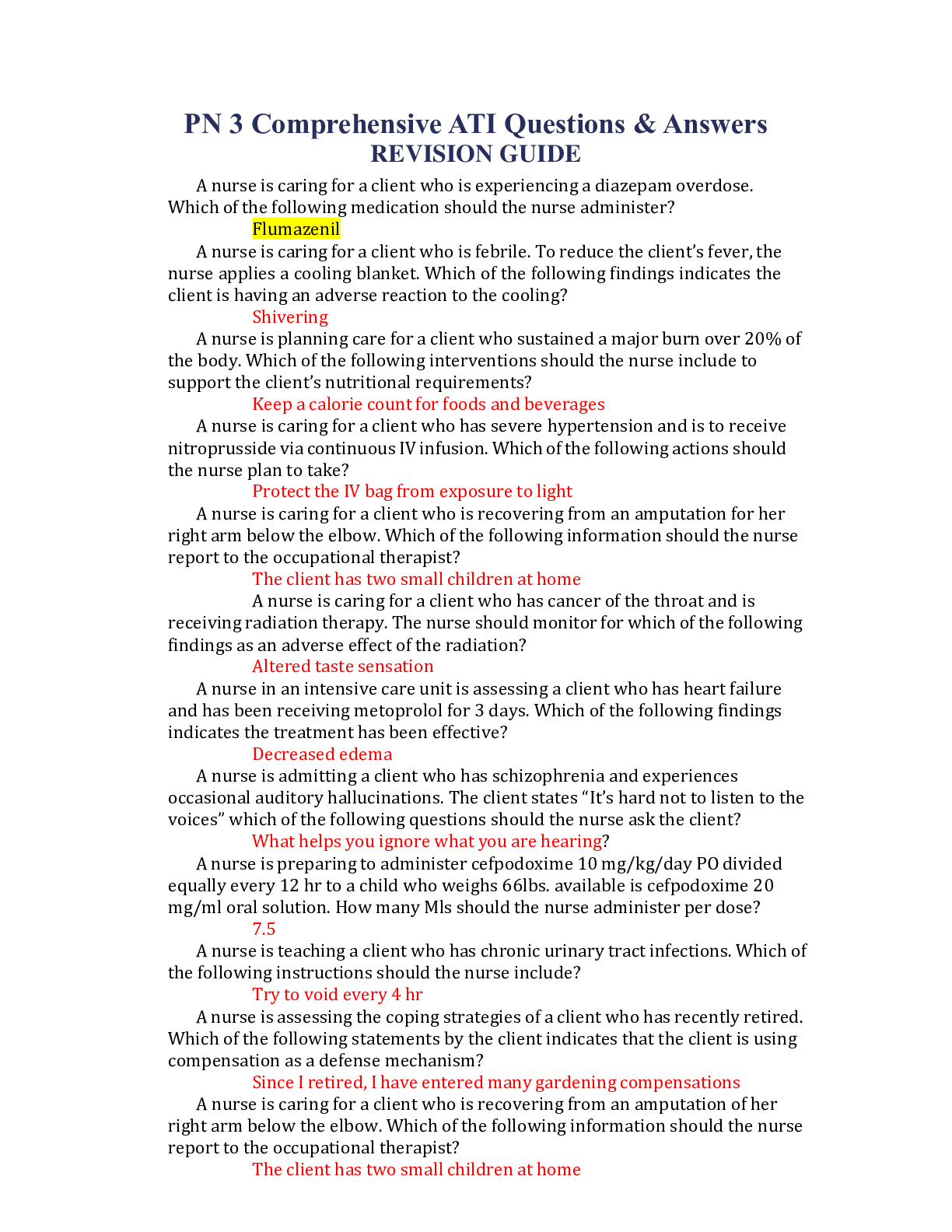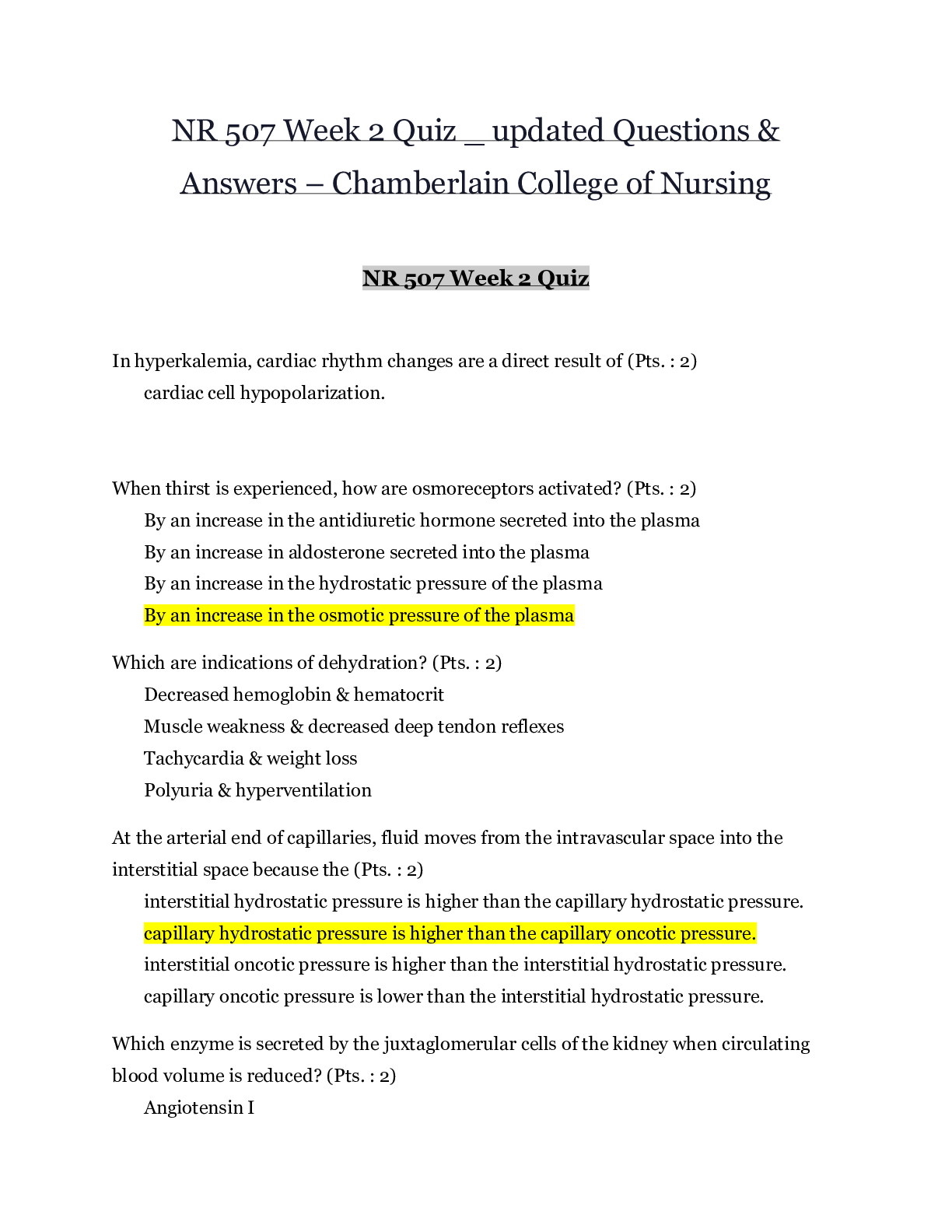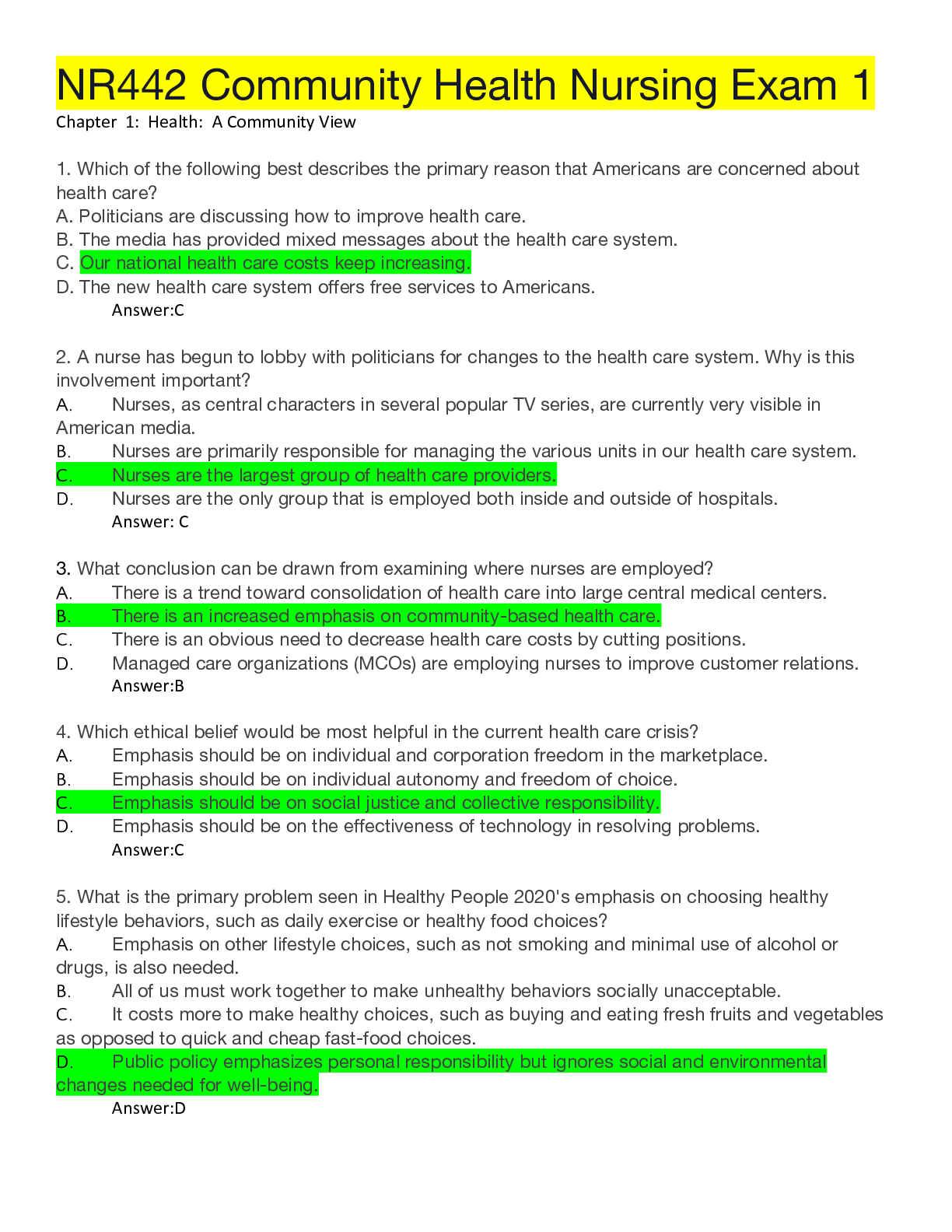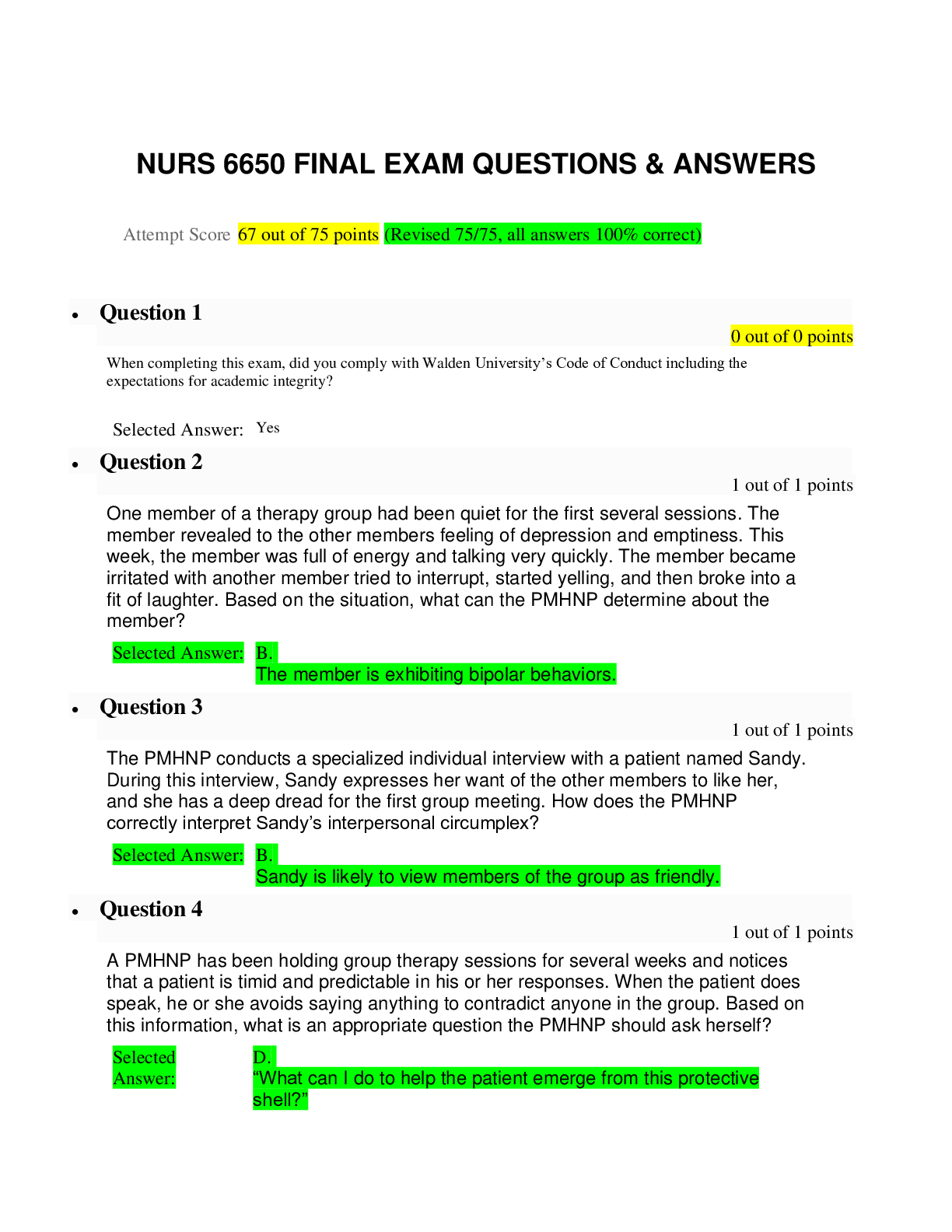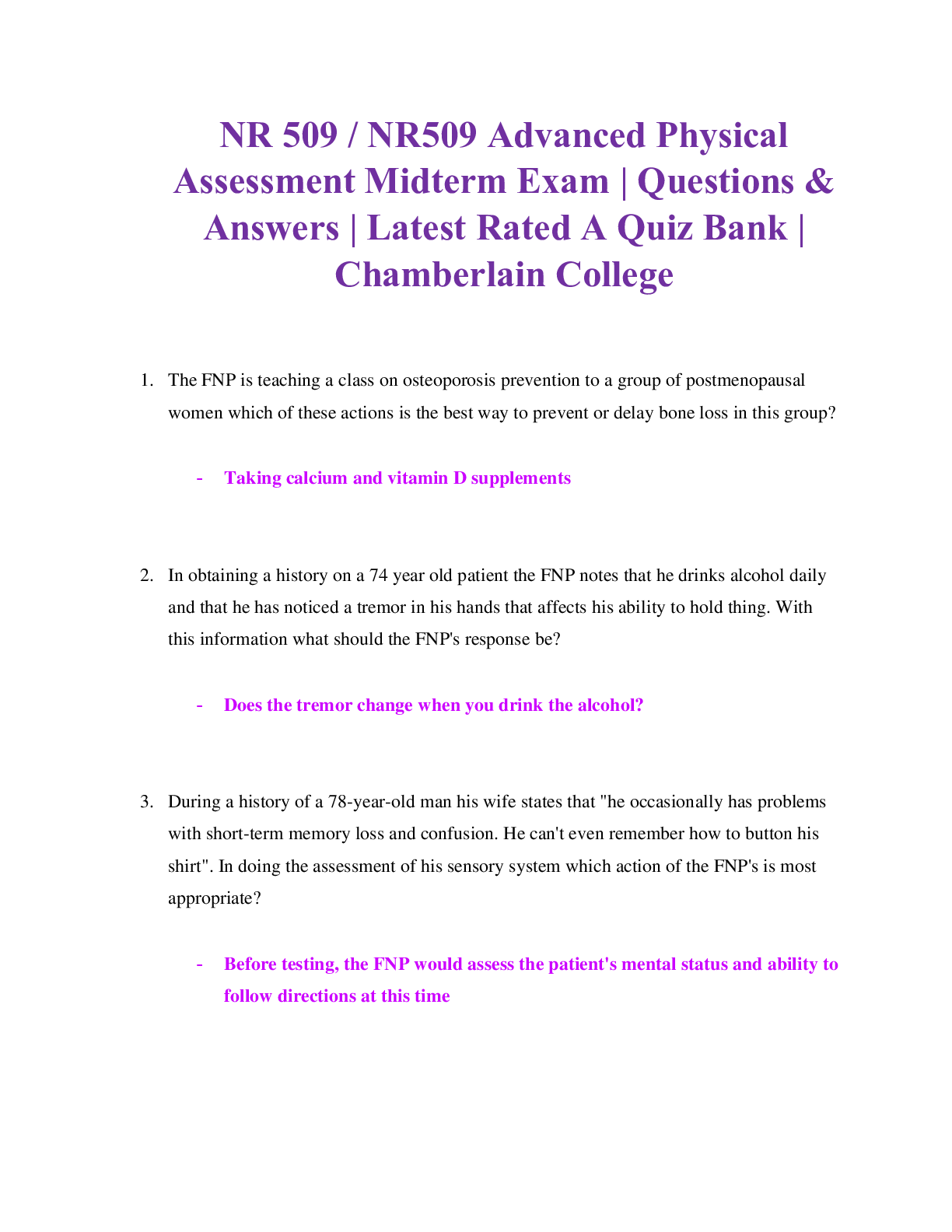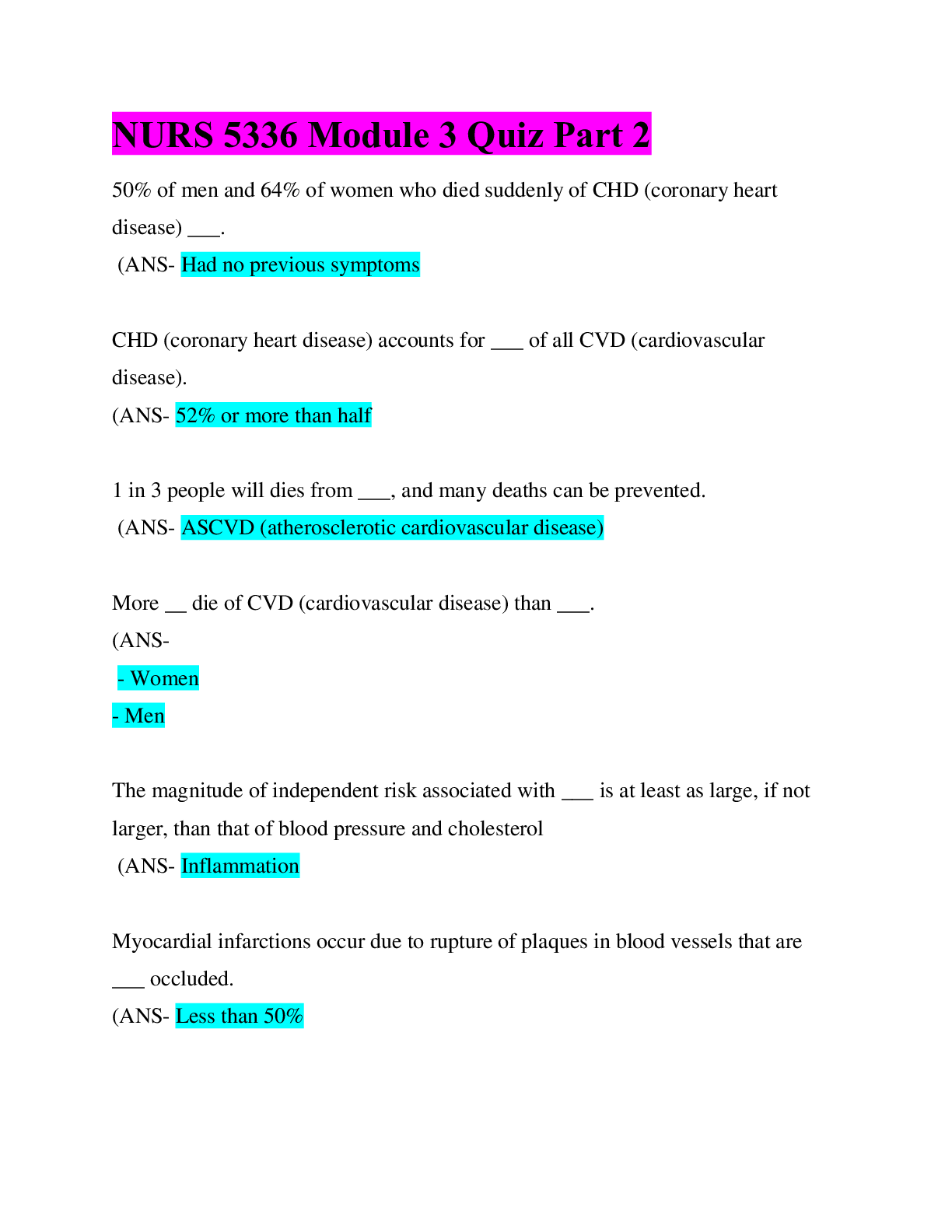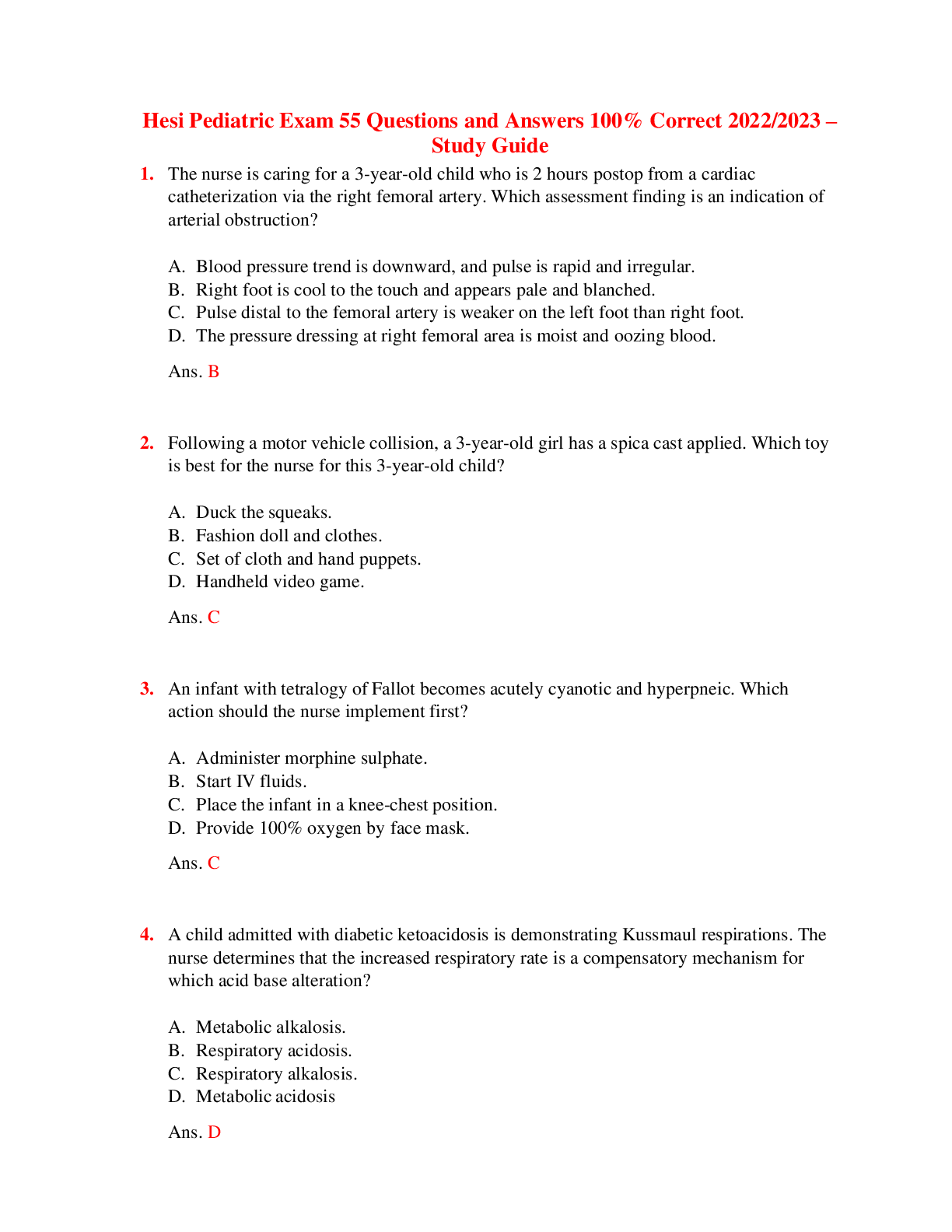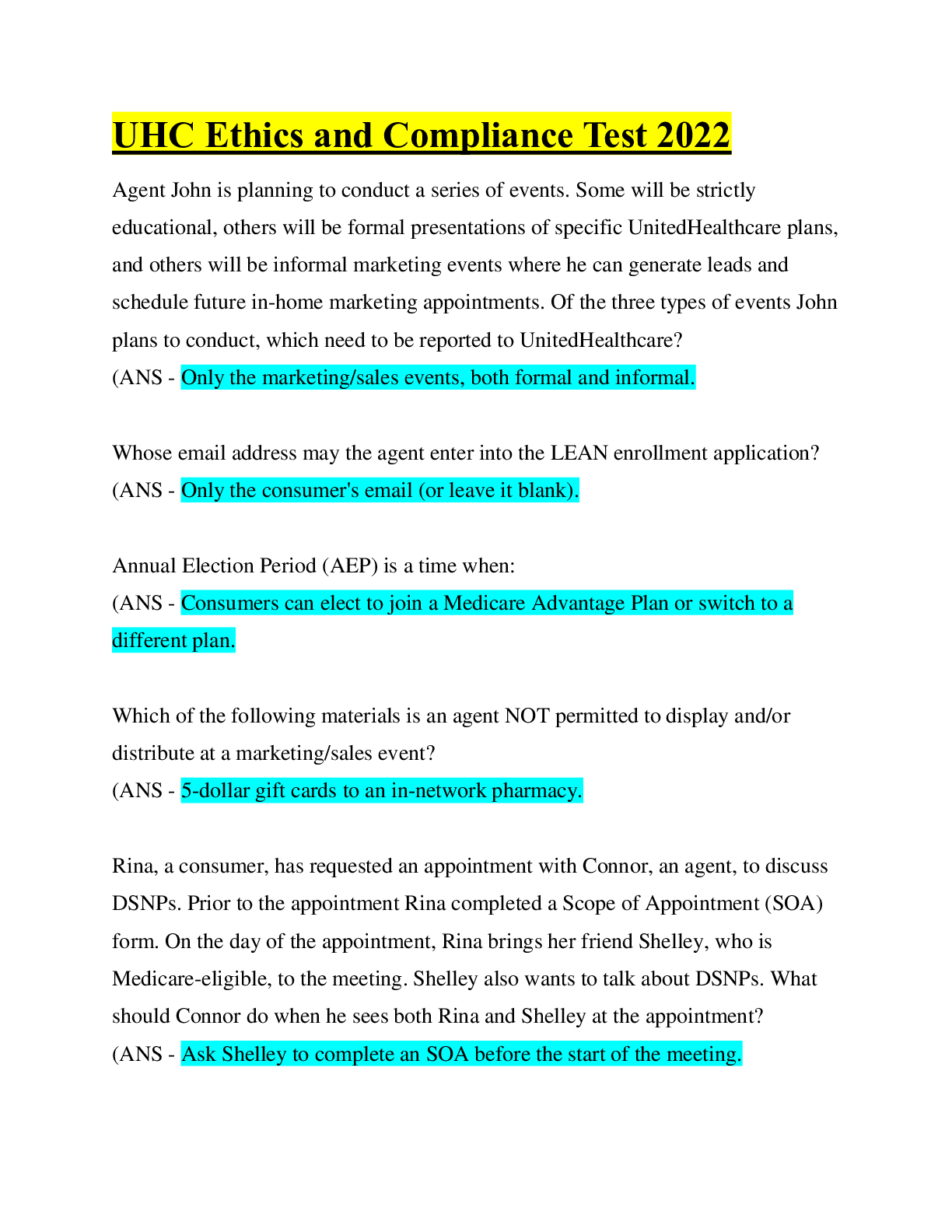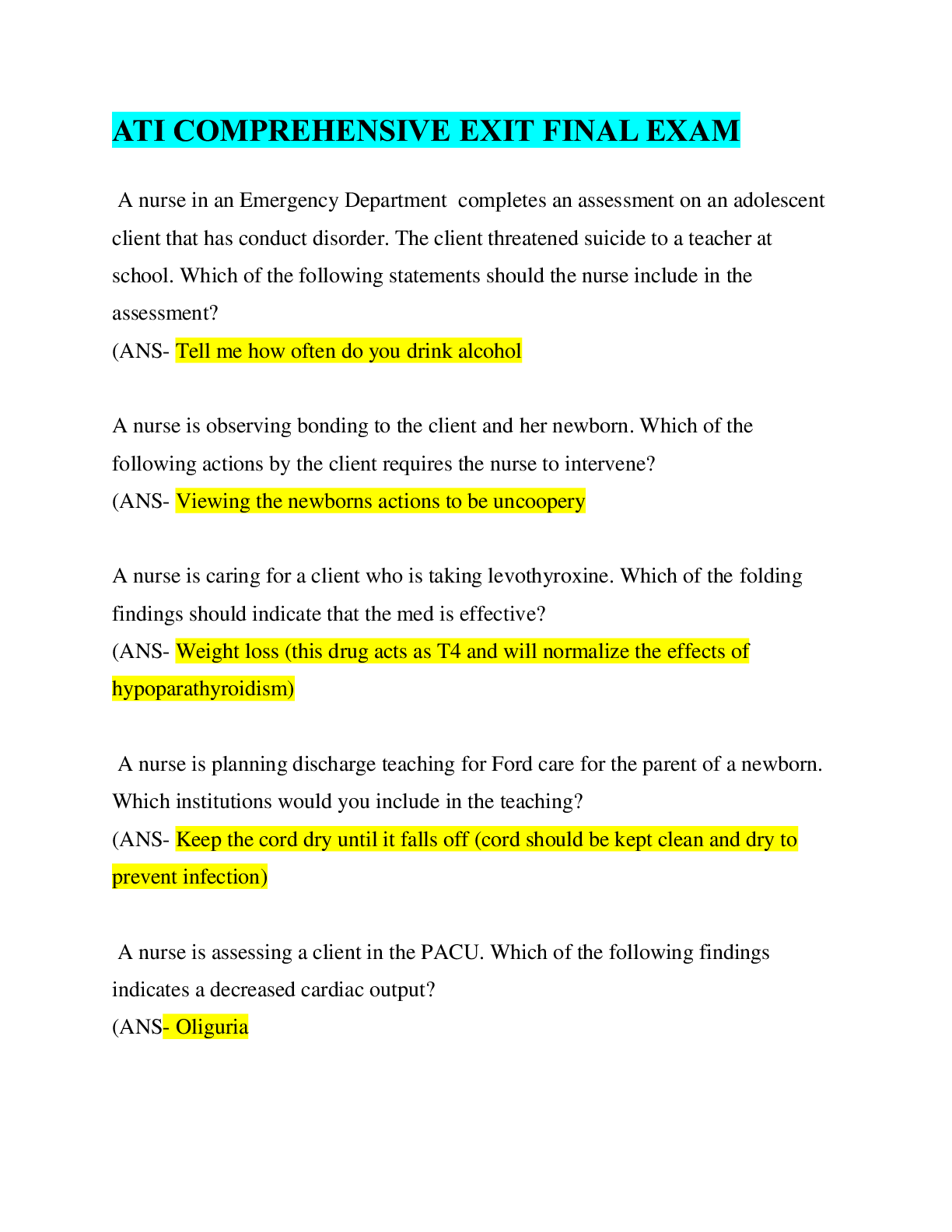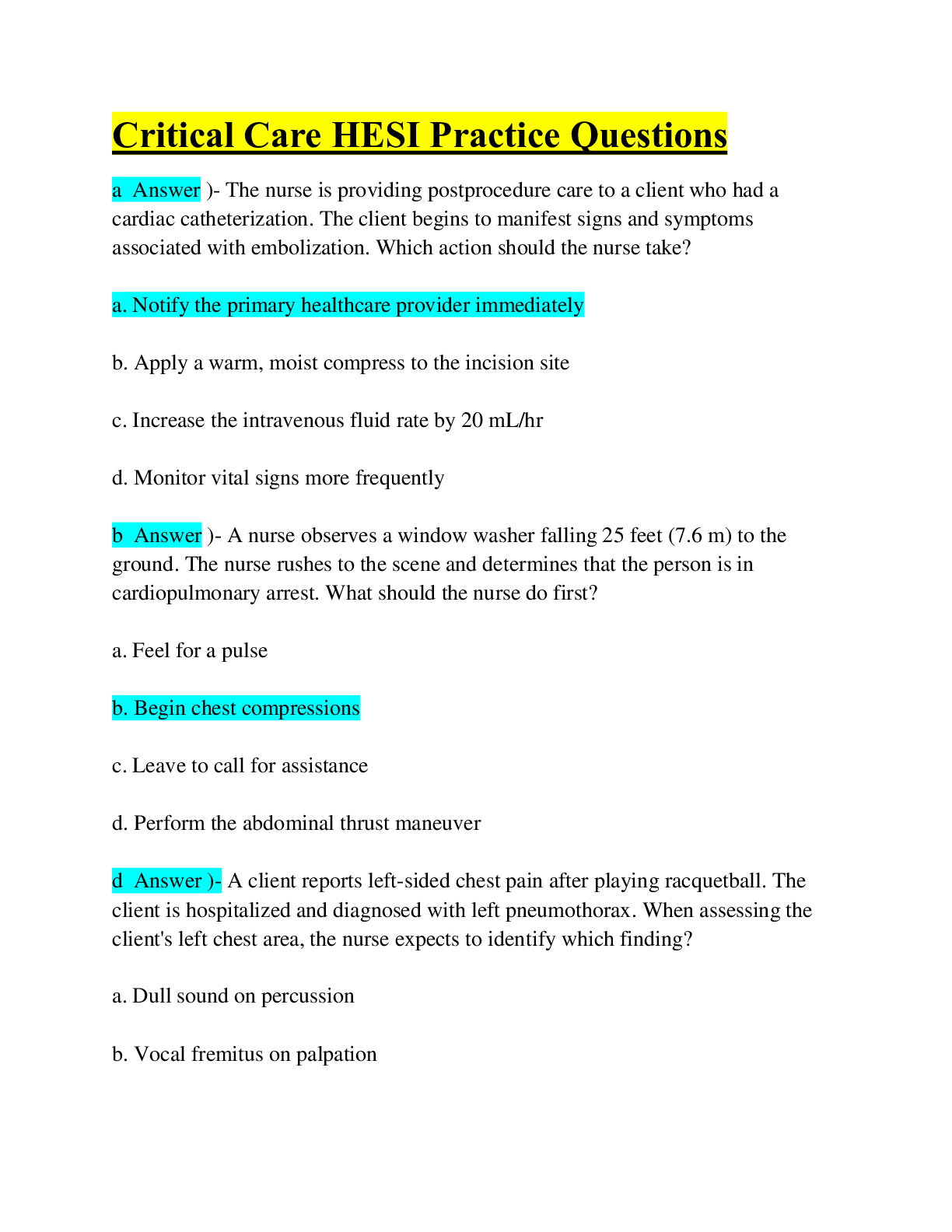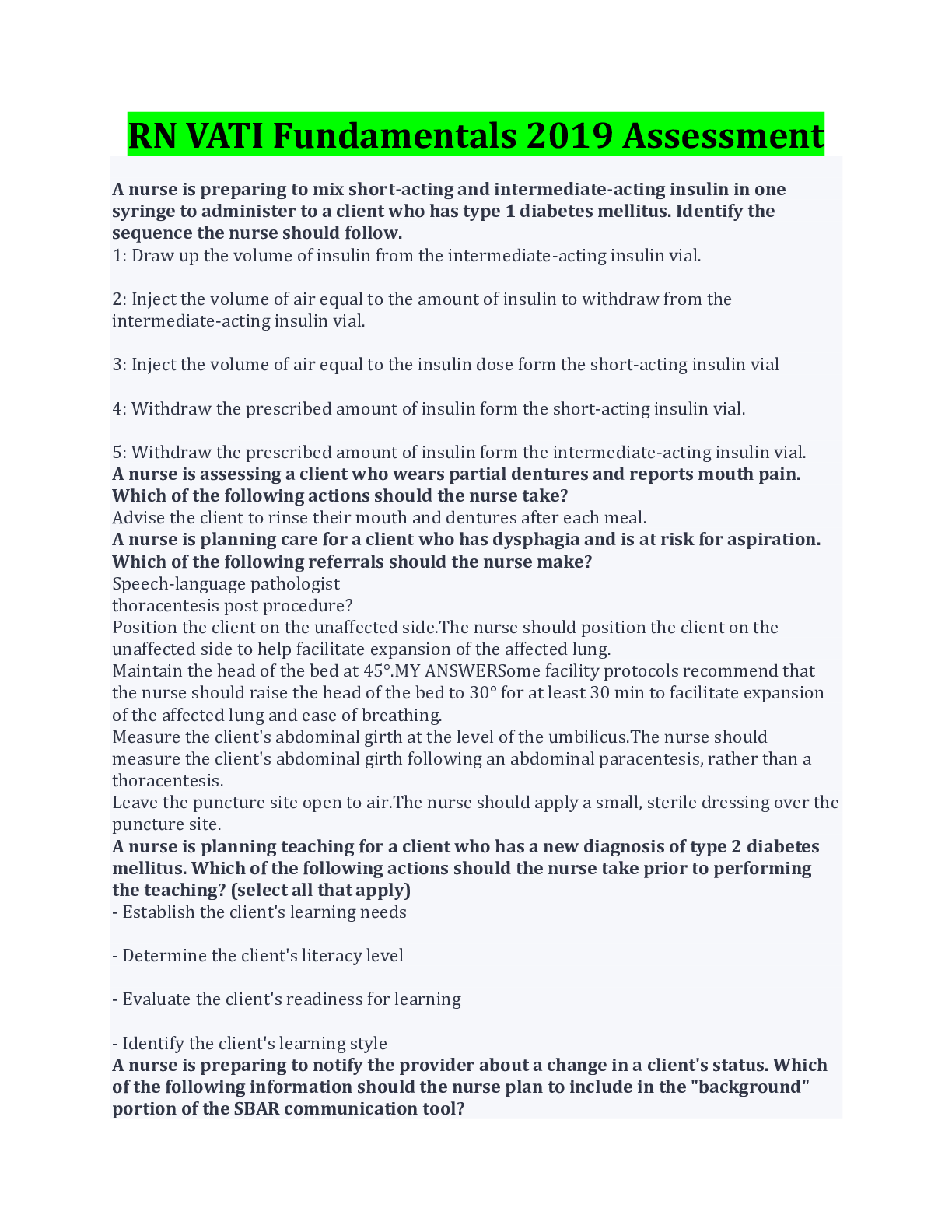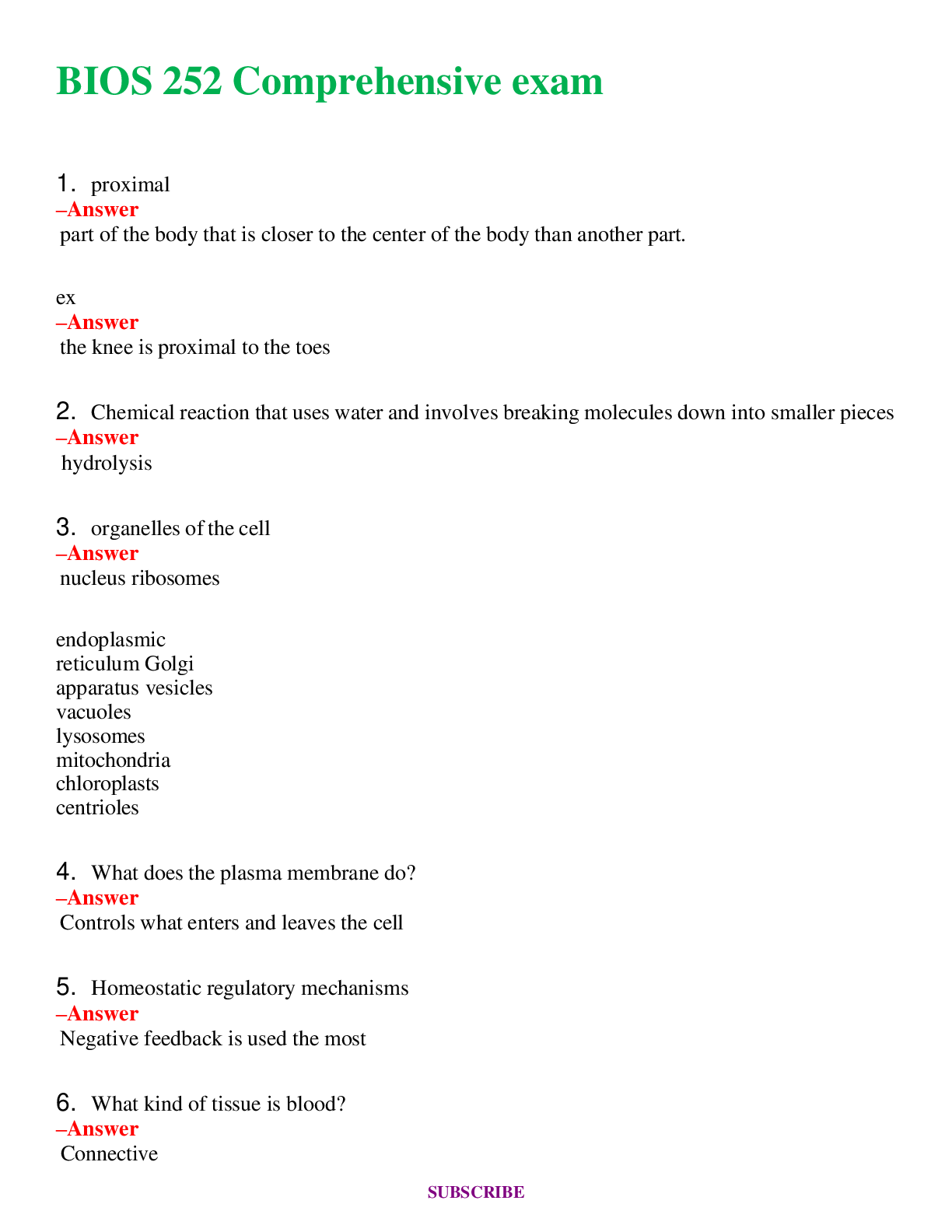*NURSING > EXAM > HESI Extra Credit module 9 Questions & Answers with complete solutions) Latest Updated Graded A+ (All)
HESI Extra Credit module 9 Questions & Answers with complete solutions) Latest Updated Graded A+
Document Content and Description Below
1. Questions 1. 1.ID: 9477047208 A client who has undergone abdominal surgery calls the nurse and reports that she just felt “something give way” in the abdominal incision. The nurse checks ... the incision and notes the presence of wound dehiscence. The nurse should take which immediate action? A. Document the findings B. Contact the health care provider C. Place the client in a supine position with the legs flat D. Cover the abdominal wound with a sterile dressing moistened with sterile saline solution Correct Rationale: Wound dehiscence is the disruption of a surgical incision or wound. When dehiscence occurs, the nurse immediately places the client in a low Fowler’s position or supine with the knees bent and instructs the client to lie quietly. These actions will minimize protrusion of the underlying tissues. The nurse then covers the wound with a sterile dressing moistened with sterile saline. The health care provider is notified, and the nurse documents the occurrence and the nursing actions that were implemented in response. Test-Taking Strategy: Note the strategic word “immediate.” Visualize this occurrence and recall that the primary concern when wound dehiscence occurs is the protrusion of underlying tissues. This will direct you to the correct option. Review the nursing actions to be taken immediately in the event of wound dehiscence Level of Cognitive Ability: Applying Client Needs: Physiological Integrity Integrated Process: Nursing Process/Implementation Content Area: Perioperative Care Giddens Concepts: Caregiving, Tissue Integrity HESI Concepts: Caregiving, Tissue Integrity Reference: Lewis, S., Dirksen, S., Heitkemper, M., & Bucher, L. (2014). Medical-surgical nursing: Assessment and management of clinical problems (9th ed., p. 180). St. Louis: Mosby. Awarded 1.0 points out of 1.0 possible points. 2. 2.ID: 9477054249 A client who just returned from the recovery room after a tonsillectomy and adenoidectomy is restless and the pulse rate is increased. As the nurse continues the assessment, the client begins to vomit a copious amount of bright-red blood. The nurse should take which immediate action? A. Notify the surgeon Correct B. Continue the assessment Extra Credit HESI Module 9 C. Check the client’s blood pressure D. Obtain a flashlight, gauze, and a curved hemostat Rationale: Hemorrhage is a potential complication after tonsillectomy and adenoidectomy. If the client vomits a large amount of bright-red blood or the pulse rate increases and the patient is restless, the nurse must notify the surgeon immediately. The nurse should obtain a light, mirror, gauze, curved hemostat, and waste basin to facilitate examination of the surgical site. The nurse should also gather additional assessment data, but the surgeon must be contacted immediately. Test-Taking Strategy: Note the strategic word, immediate. Noting the words “bright-red blood” will assist in directing you to the correct option. Remember that the presence of bright-red blood indicates active bleeding. Review the nursing actions to be taken immediately when bleeding occurs after a tonsillectomy and adenoidectomy Level of Cognitive Ability: Applying Client Needs: Physiological Integrity Integrated Process: Nursing Process/Implementation Content Area: Critical Care: Emergency Situation/Management Giddens Concepts: Collaboration, Clotting HESI Concepts: Collaboration/Managing Care, Perfusion-Clotting Reference: Ignatavicius, D., & Workman, M. (2013). Medical-surgical nursing: Patient-centered collaborative care. (7th ed., p. 644). St. Louis: Saunders. Awarded 1.0 points out of 1.0 possible points. 3. 3.ID: 9477051455 A client who has just undergone surgery suddenly experiences chest pain, dyspnea, and tachypnea. The nurse suspects that the client has a pulmonary embolism and immediately sets about to take which action? A. Preparing the client for a perfusion scan B. Attaching the client to a cardiac monitor C. Administering oxygen by way of nasal cannula Correct D. Ensuring that the intravenous (IV) line is patent Rationale: Pulmonary embolism is a life-threatening emergency. Oxygen is immediately administered nasally to relieve hypoxemia, respiratory distress, and central cyanosis, and the health care provideris notified. IV infusion lines are needed to administer medications or fluids. A perfusion scan, among other tests, may be performed. The electrocardiogram is monitored for the presence of dysrhythmias. Additionally, a urinary catheter may be inserted and blood for arterial blood gas determinations drawn. The immediate priority, however, is the administration of oxygen. Test-Taking Strategy: Focus on the client’s diagnosis and use the skills of Extra Credit HESI Module 9 prioritizing. Use the ABCs (airway, breathing, and circulation) to find the correct option. Review the nursing actions to be taken immediately in the event of pulmonary embolism Level of Cognitive Ability: Applying Client Needs: Physiological Integrity Integrated Process: Nursing Process/Implementation Content Area: Critical Care: Emergency Situation/Management Giddens Concepts: Perfusion, Clotting HESI Concepts: Oxygenation/Gas Exchange, Perfusion-Clotting Reference: Lewis, S., Dirksen, S., Heitkemper, M., & Bucher, L. (2014). Medical-surgical nursing: Assessment and management of clinical problems (9th ed., p. 552). St. Louis: Mosby. Awarded 1.0 points out of 1.0 possible points. 4. 4.ID: 9477051498 A nurse is assessing a client who has a closed chest tube drainage system. The nurse notes constant bubbling in the water seal chamber. What actions should the nurse take? (Select all that apply). A. Clamp the chest tube B. Chang the drainage system C. Assess the system for an external air leak Correct D. Reduce the degree of suction being applied E. Document assessment findings, actions taken, and client response Correct Rationale: Constant bubbling in the water seal chamber of a closed chest tube drainage system may indicate the presence of an air leak. The nurse would assess the chest tube system for the presence of an external air leak if constant bubbling were noted in this chamber. If an external air leak is not present and the air leak is a new occurrence, the health care provider is notified immediately, because an air leak may be present in the pleural space. Leakage and trapping of air in the pleural space can result in a tension pneumothorax. Clamping the chest tube is incorrect. Additionally, a chest tube is not clamped unless this has been specifically prescribed in the agency’s policies and procedures. Changing the drainage system will not alleviate the problem. Reducing the degree of suction being applied will not affect the bubbling in the water seal chamber and could be harmful. The nurse would document the assessment findings and interventions taken in the client’s medical record. Test-Taking Strategy: Focus on the data in the question, noting that there is bubbling in the water seal chamber. Use knowledge regarding the priority actions in the care of a closed chest tube drainage system. Recalling that this may indicate an air leak will direct you to the correct options. Review the Extra Credit HESI Module 9 nursing actions to be taken immediately in the event that complications of a closed chest tube drainage system occur Level of Cognitive Ability: Applying Client Needs: Physiological Integrity Integrated Process: Nursing Process/Implementation Content Area: Critical Care: Emergency Situation/Management Giddens Concepts: Care Coordination, Gas Exchange HESI Concepts: Nursing Interventions, Oxygenation/Gas Exchange Reference: Lewis, S., Dirksen, S., Heitkemper, M., & Bucher, L. (2014). Medical-surgical nursing: Assessment and management of clinical problems (9th ed., p. 546). St. Louis: Mosby. Awarded 2.0 points out of 2.0 possible points. 5. 5.ID: 9477055619 A nurse is helping a client with a closed chest tube drainage system get out of bed and into a chair. During the transfer, the chest tube is caught on the leg of the chair and dislodged from the insertion site. What is the immediate nursing action? A. Reinsert the chest tube B. Contact the health care provider C. Transfer the client back to bed D. Cover the insertion site with a sterile occlusive dressing Correct Rationale: If a chest tube is dislodged from the insertion site, the nurse immediately covers the site with sterile occlusive dressing. The nurse then performs a respiratory assessment, helps the client back into bed, and contacts the health care provider. The nurse does not reinsert the chest tube. The health care provider will reinsert the chest tube as necessary. Test-Taking Strategy: Note the strategic word “immediate.” Eliminate the option that involves reinsertion of the chest tube first, because a nurse is not trained to insert a chest tube. To select from the remaining options, focus on the subject, dislodgment of a chest tube from its insertion site, and recall the complications associated with this occurrence; this will direct you to the correct option. Review the nursing actions to be taken immediately in the event of complications associated with a closed chest tube drainage system Level of Cognitive Ability: Applying Client Needs: Physiological Integrity Integrated Process: Nursing Process/Implementation Content Area: Critical Care: Emergency Situation/Management Giddens Concepts: Care Coordination, Gas Exchange Extra Credit HESI Module 9 HESI Concepts: Nursing Interventions, Oxygenation/Gas Exchange Reference: Lewis, S., Dirksen, S., Heitkemper, M., & Bucher, L. (2014). Medical-surgical nursing: Assessment and management of clinical problems (9th ed., p. 546). St. Louis: Mosby. Awarded 1.0 points out of 1.0 possible points. 6. 6.ID: 9477047967 A nurse performing nasopharyngeal suctioning and suddenly notes the presence of bloody secretions. Which action should the nurse take first? A. Continue suctioning to remove the blood B. Check the degree of suction being applied Correct C. Encourage the client to cough out the bloody secretions D. Remove the suction catheter from the client’s nose and begin vigorous suctioning through the mouth Rationale: The return of bloody secretions is an unexpected outcome of suctioning. If it occurs, the nurse should first assess the client and then determine the degree of suction being applied. The degree of suction pressure may need to be decreased. The nurse must also remember to apply intermittent suction and perform catheter rotation during suctioning. Continuing the suctioning or performing vigorous suctioning through the mouth will result in increased trauma and therefore increased bleeding. Suctioning is normally performed on clients who are unable to expectorate secretions. It is therefore unlikely that the client will be able to cough out the bloody secretions. Test-Taking Strategy: Note the strategic word, first. Eliminate the options of continuing the suctioning to remove the blood and removing the suction catheter from the nose to begin vigorous suctioning through the mouth, because they are comparable or alike. Next eliminate the option that involves encouraging the client to cough out the bloody secretions, because it is unlikely that the client will be able to do so. Review the nursing actions to be taken immediately in the event of a complication during suctioning Level of Cognitive Ability: Applying Client Needs: Physiological Integrity Integrated Process: Nursing Process/Implementation Content Area: Adult Health/Respiratory Giddens Concepts: Clinical Judgment, Gas Exchange HESI Concepts: Clinical Decision-Making/Clinical Judgment, Oxygenation/Gas Exchange Reference: Perry, A., Potter, P., & Ostendorf, W. (2014). Clinical nursing skills & techniques (8th ed., pp. 629, 635). St. Louis: Mosby. Awarded 1.0 points out of 1.0 possible points. 7. 7.ID: 9477054269 Extra Credit HESI Module 9 A nurse is suctioning a client through a tracheostomy tube. During the procedure, the client begins to cough, and the nurse hears a wheeze. The nurse tries to remove the suction catheter from the client’s trachea but is unable to do so. Which action should the nurse take first? A. Call a code B. Contact the health care provider C. Administer a bronchodilator D. Disconnect the suction source from the catheter Correct Rationale: Inability to remove a suction catheter is a critical situation. This finding, along with the client’s symptoms presented in the question, indicates the presence of bronchospasm and bronchoconstriction. The nurse immediately disconnects the suction source from the catheter but leave the catheter in the trachea. The nurse then connects the oxygen source to the catheter. The health care provider is notified and will most likely prescribe an inhaled bronchodilator. The nurse also prepares for emergency resuscitation if the bronchospasm is not relieved. Test-Taking Strategy: Note the strategic word “first.” Eliminate the option of administering a bronchodilator, because this action requires a health care provider’s prescription. To select from the remaining options, visualize the situation presented in the question. Noting that the nurse is unable to remove the suction catheter from the client’s trachea will direct you to the correct option. Review the nursing actions to be taken immediately in the event of a complication during suctioning Level of Cognitive Ability: Applying Client Needs: Physiological Integrity Integrated Process: Nursing Process/Implementation Content Area: Adult Health/Respiratory Giddens Concepts: Clinical Judgment, Gas Exchange HESI Concepts: Clinical Decision-Making/Clinical Judgment, Oxygenation/Gas Exchange Reference: Ignatavicius, D., & Workman, M. (2013). Medical-surgical nursing: Patient-centered collaborative care. (7th ed., pp. 574-575). St. Louis: Saunders. Awarded 1.0 points out of 1.0 possible points. 8. 8.ID: 9477044479 A nurse assesses the closed chest tube drainage system of a client who underwent lobectomy 24 hours ago. The nurse notes that there has been no chest tube drainage for the past hour. Which action should the nurse take first? A. Contact the health care provider B. Check for kinks in the drainage system Correct C. Check the client’s blood pressure and heart rate Extra Credit HESI Module 9 D. Connect a new drainage system to the client’s chest tube Rationale: If a chest tube is not draining, the nurse must first check for a kink or clot in the chest drainage system. The nurse also observes the client for signs of respiratory distress or mediastinal shift; and if such signs are noted, the health care provider is notified. Checking the heart rate and blood pressure is not directly related to the lack of chest tube drainage. Connecting a new drainage system to the client’s chest tube is done once the fluid drainage chamber is full. A specific procedure is followed when a new drainage system is connected to a client’s chest tube. Test-Taking Strategy: Note strategic word “first.” Focusing on the subject, a lack of chest tube drainage, will direct you to the correct option. Review unexpected outcomes and related interventions in the care of a chest tube drainage system Level of Cognitive Ability: Applying Client Needs: Physiological Integrity Integrated Process: Nursing Process/Implementation Content Area: Adult Health/Respiratory Giddens Concepts: Clinical Judgment, Gas Exchange HESI Concepts: Clinical Decision-Making/Clinical Judgment, Oxygenation/Gas Exchange Reference: Ignatavicius, D., & Workman, M. (2013). Medical-surgical nursing: Patient-centered collaborative care. (7th ed., p. 637). St. Louis: Saunders. Awarded 1.0 points out of 1.0 possible points. 9. 9.ID: 9477047216 A nurse is assessing a postoperative client on an hourly basis. The nurse notes that the client’s urine output for the past hour was 25 mL. On the basis of this finding, the nurse should take which action first? A. Call the health care provider B. Increase the rate of the IV infusion C. Check the client’s overall intake and output record Correct D. Administer a 250-mL bolus of normal saline solution (0.9%) Rationale: Clients are at risk for becoming hypovolemic after surgery, and often the first sign of hypovolemia is decreasing urine output. However, the nurse needs additional data to make an accurate interpretation. Neither an increase in the rate of the IV infusion nor administration of a 250-mL bolus of normal saline (0.9%) would be implemented without a prescription from the health care provider. The health care provider is called once the nurse has gathered all necessary assessment data, including the overall fluid status and vital signs. Test-Taking Strategy: Note the strategic word “first.” Try to visualize the situation and use the steps of the nursing process to answer the question. The correct option addresses the process of assessment. Eliminate increasing the rate of the IV infusion and administering a 250-mL bolus of normal saline Extra Credit HESI Module 9 (0.9%), because each requires a health care provider’s prescription. In this situation, the nurse needs to gather additional information before contacting the health care provider. Review unexpected outcomes after surgery and priority nursing interventions in the event of such outcomes Level of Cognitive Ability: Applying Client Needs: Physiological Integrity Integrated Process: Nursing Process/Implementation Content Area: Perioperative Care Giddens Concepts: Clinical Judgment, Elimination HESI Concepts: Clinical Decision-Making/Clinical Judgment, Elimination Reference: Ignatavicius, D., & Workman, M. (2013). Medical-surgical nursing: Patient-centered collaborative care. (7th ed., pp. 289-290). St. Louis: Saunders. [Show More]
Last updated: 1 year ago
Preview 1 out of 75 pages
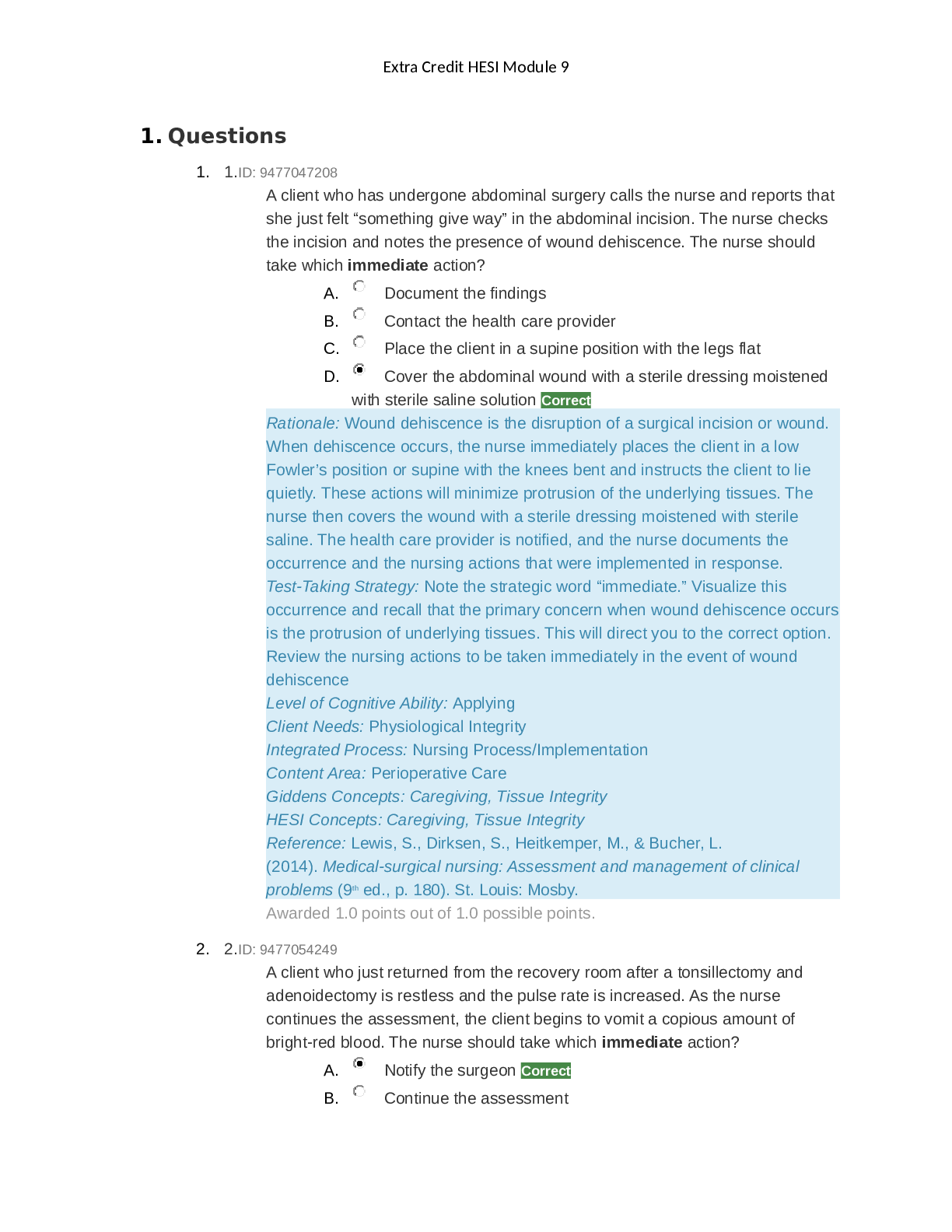
Reviews( 0 )
Document information
Connected school, study & course
About the document
Uploaded On
Jan 13, 2023
Number of pages
75
Written in
Additional information
This document has been written for:
Uploaded
Jan 13, 2023
Downloads
0
Views
38

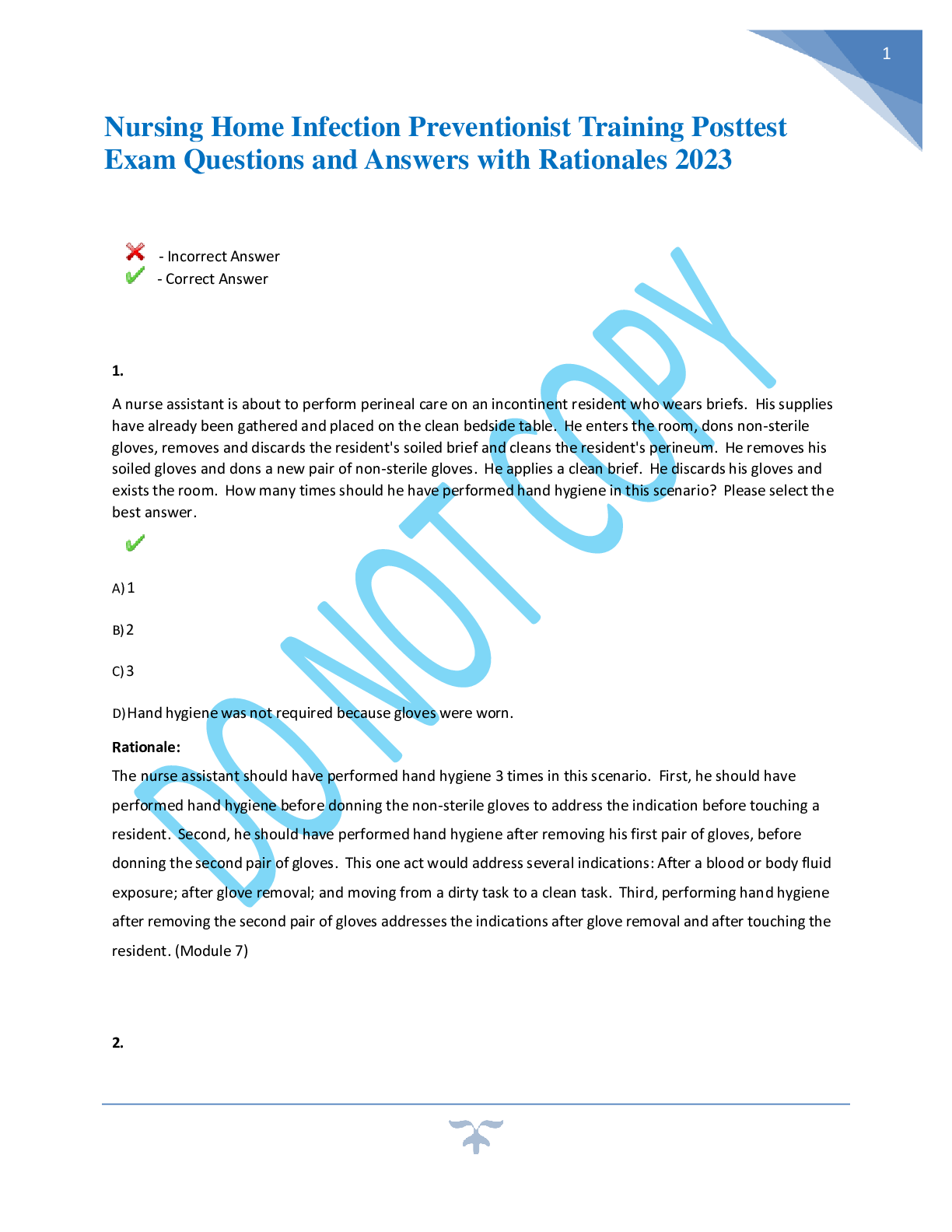
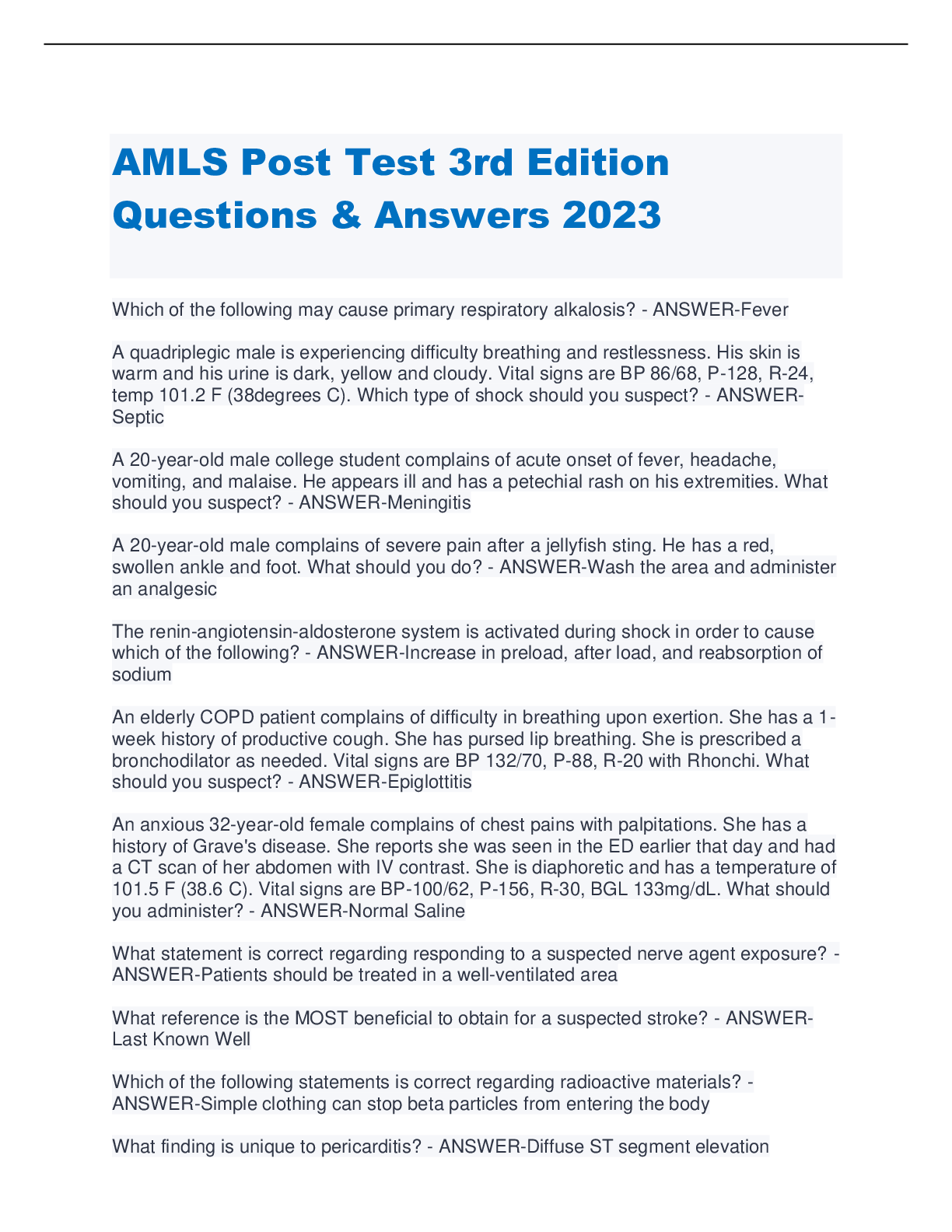
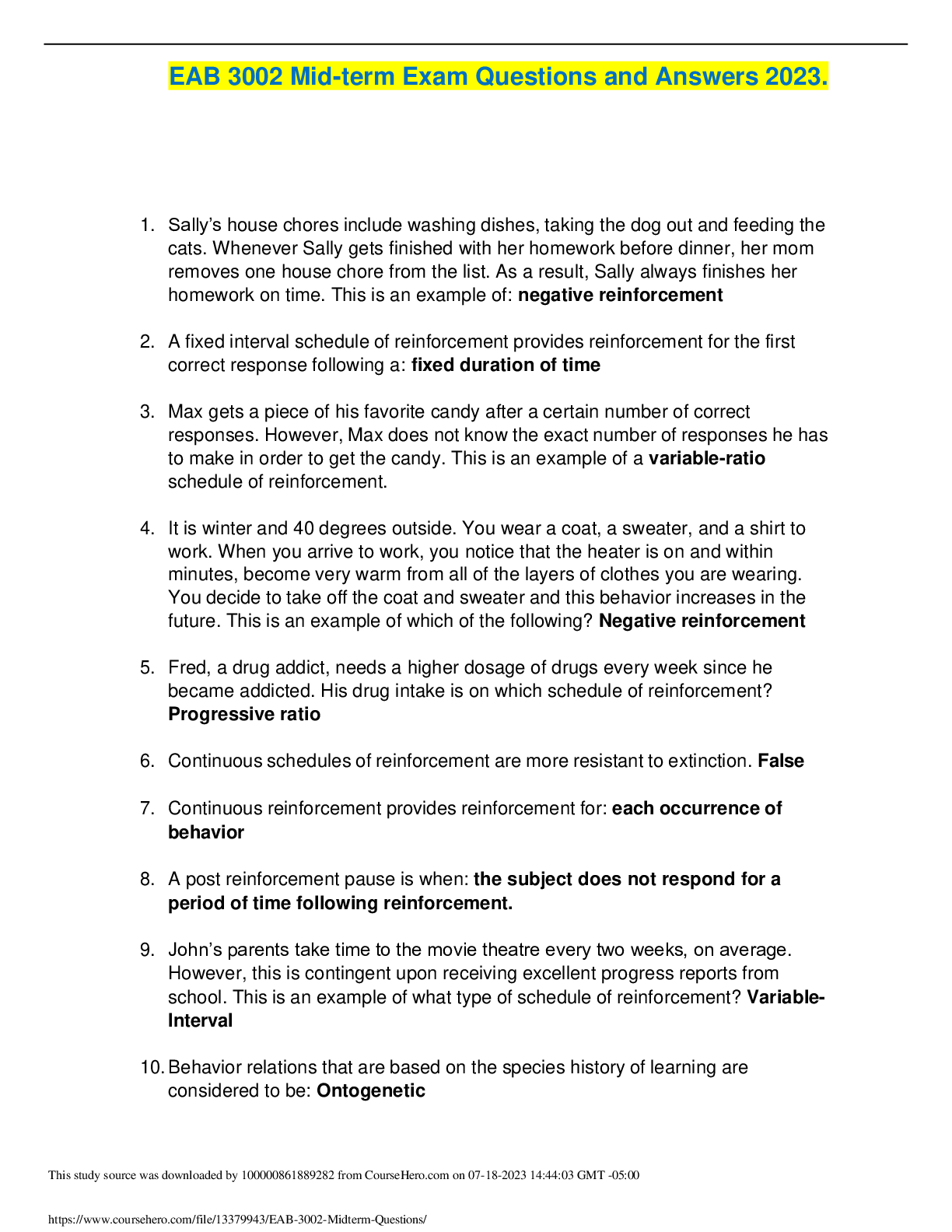

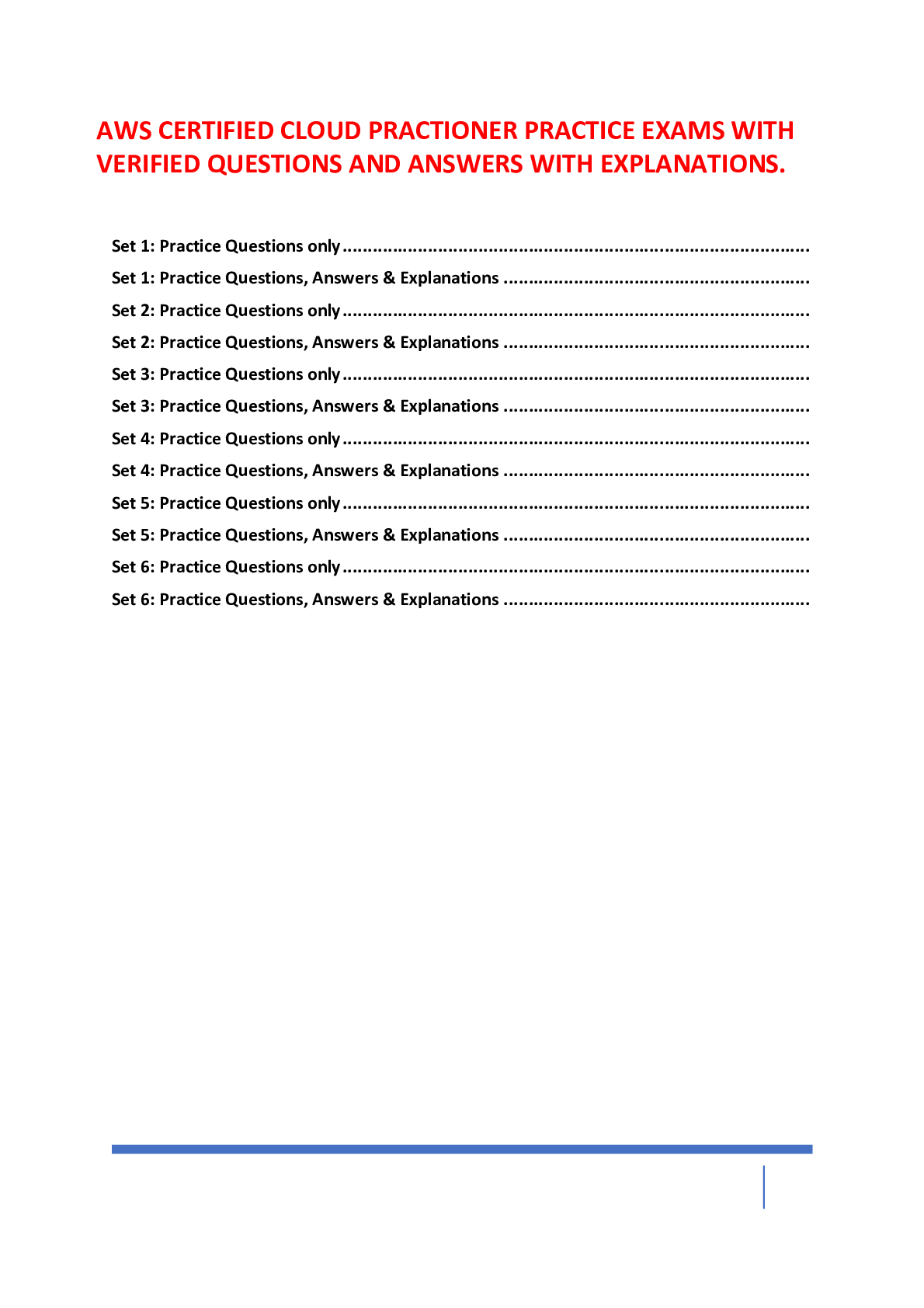
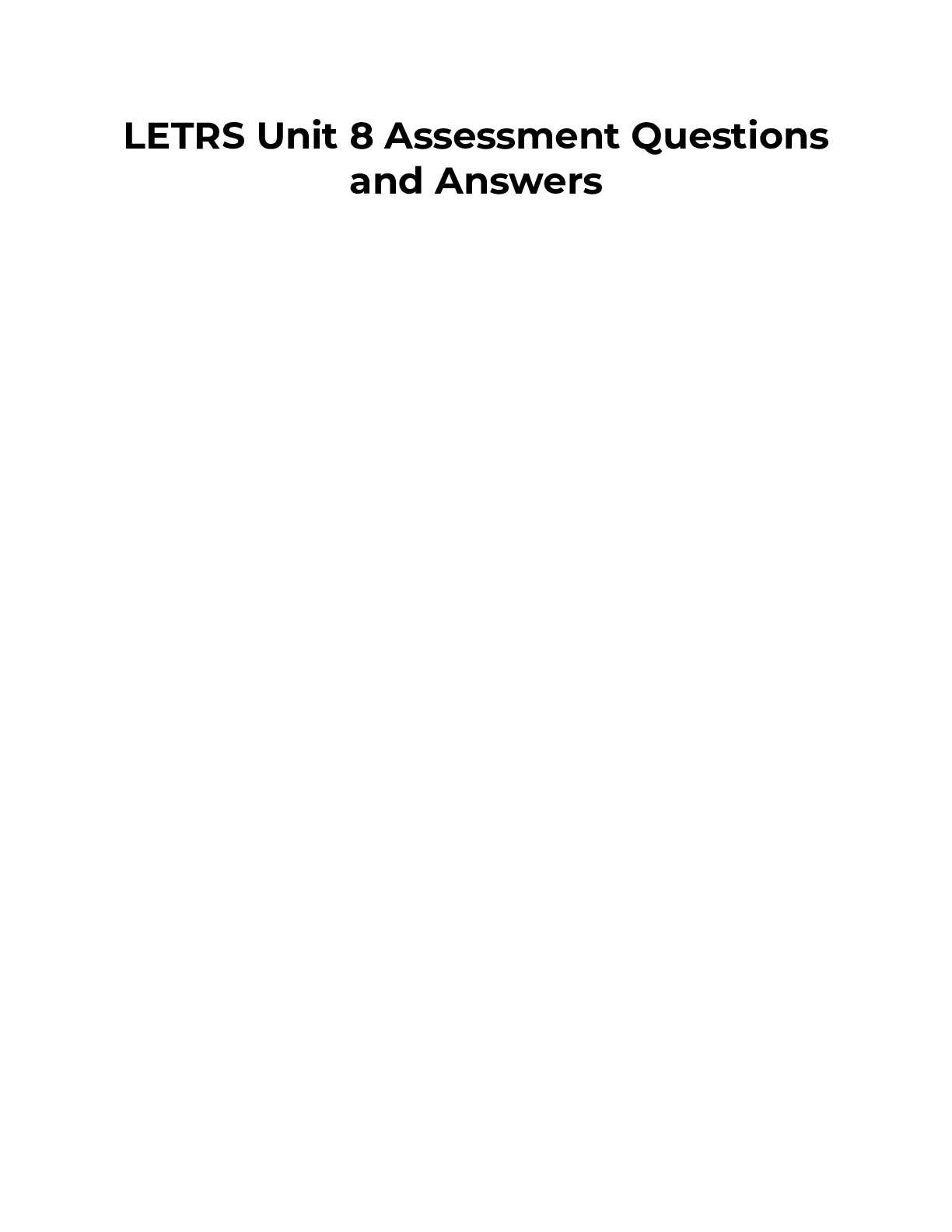
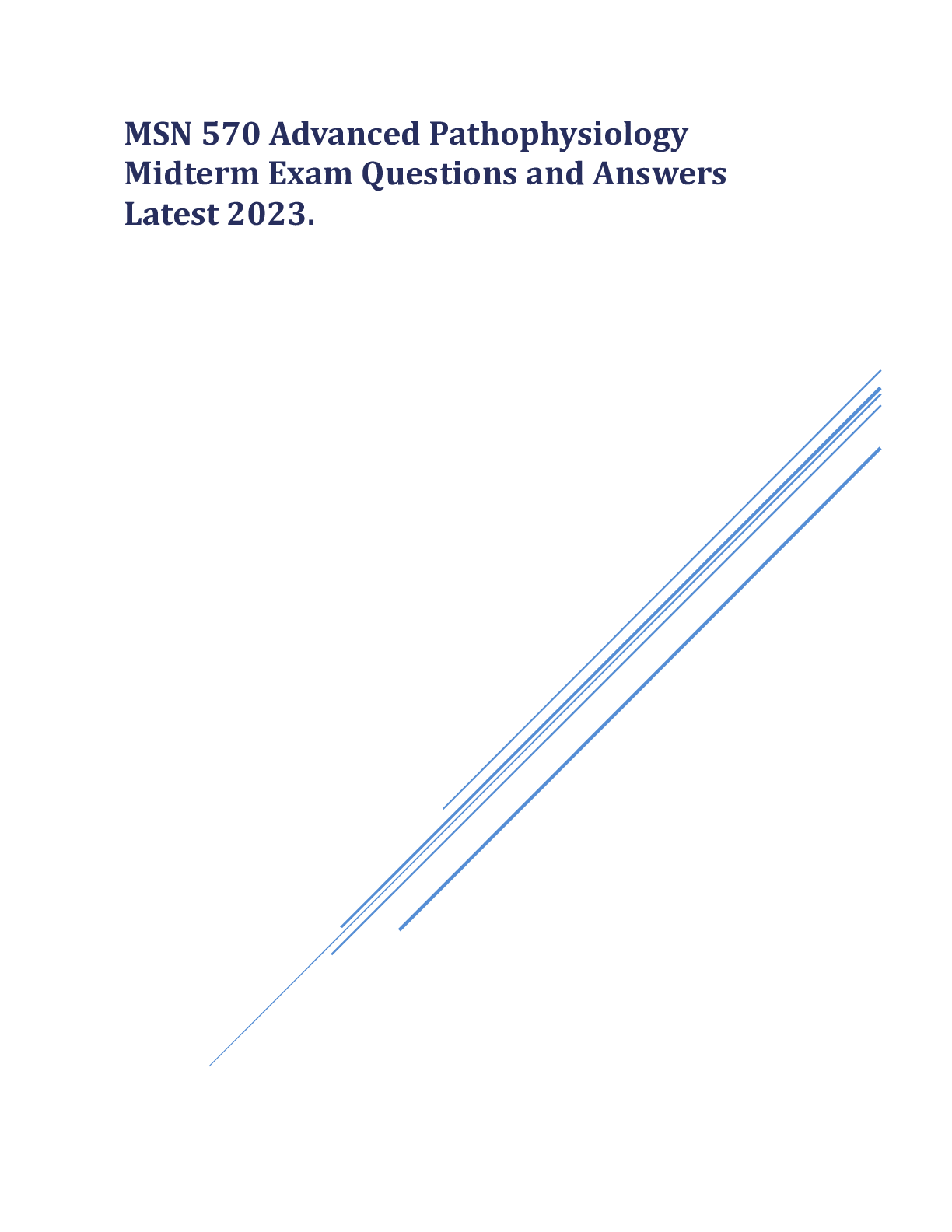
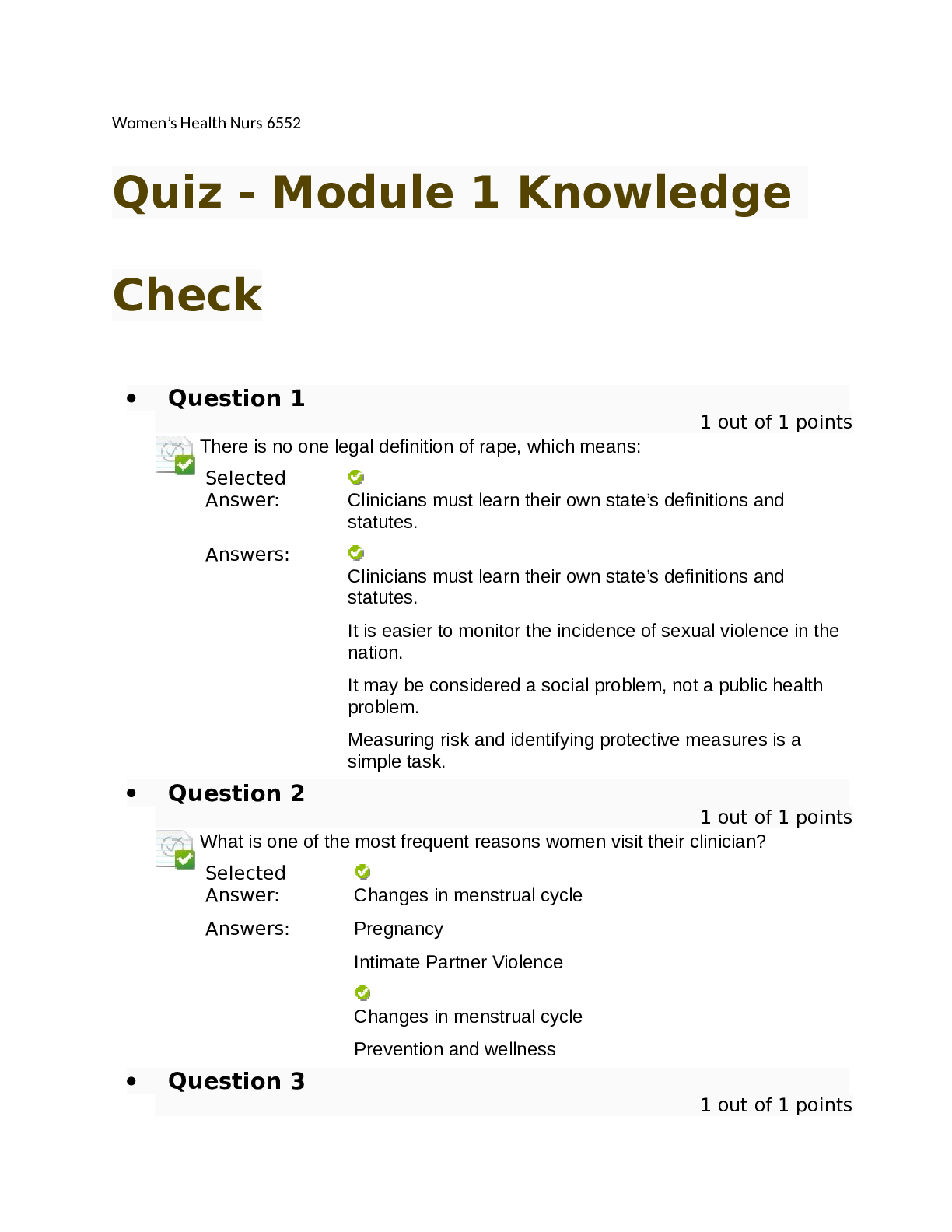


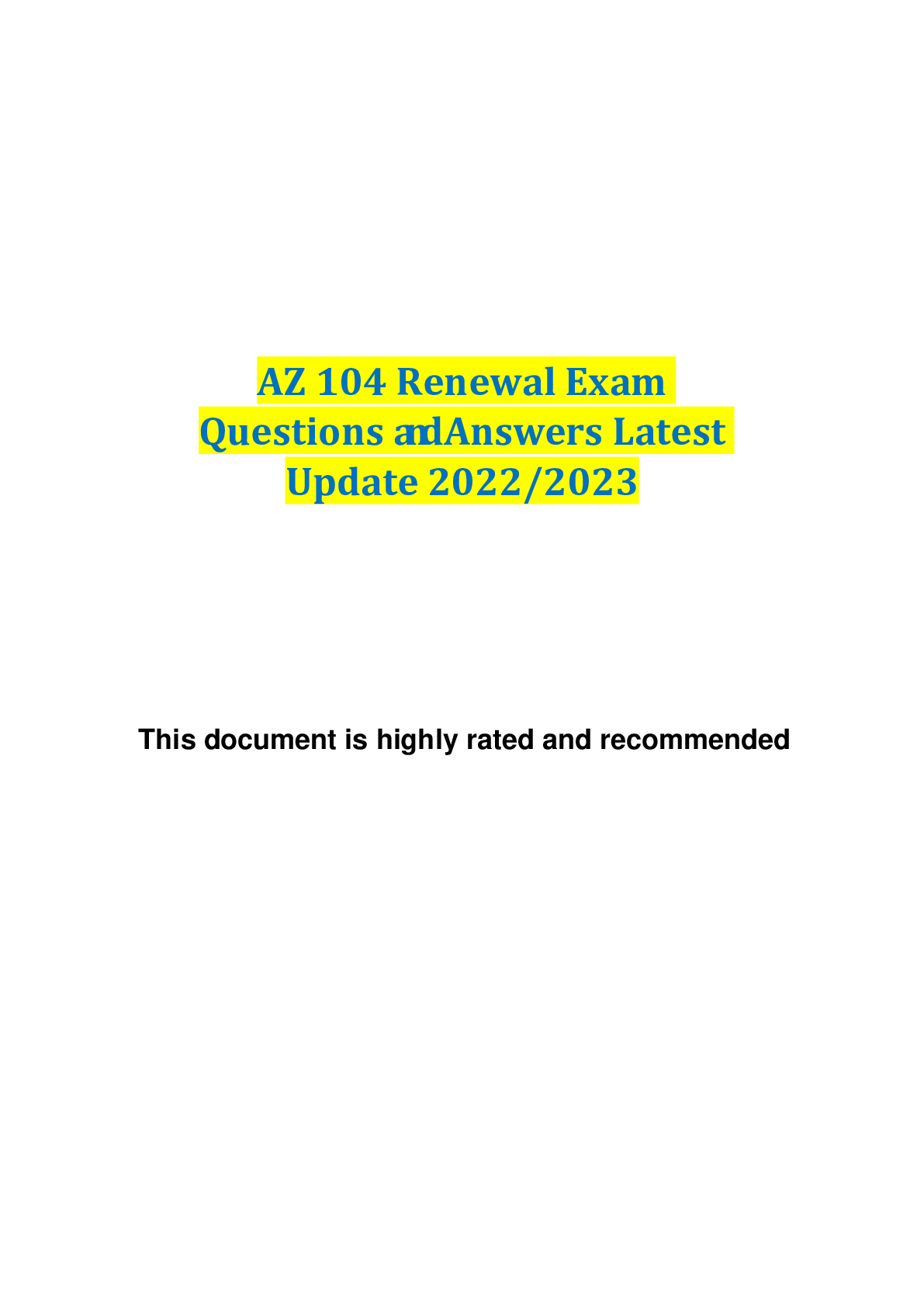
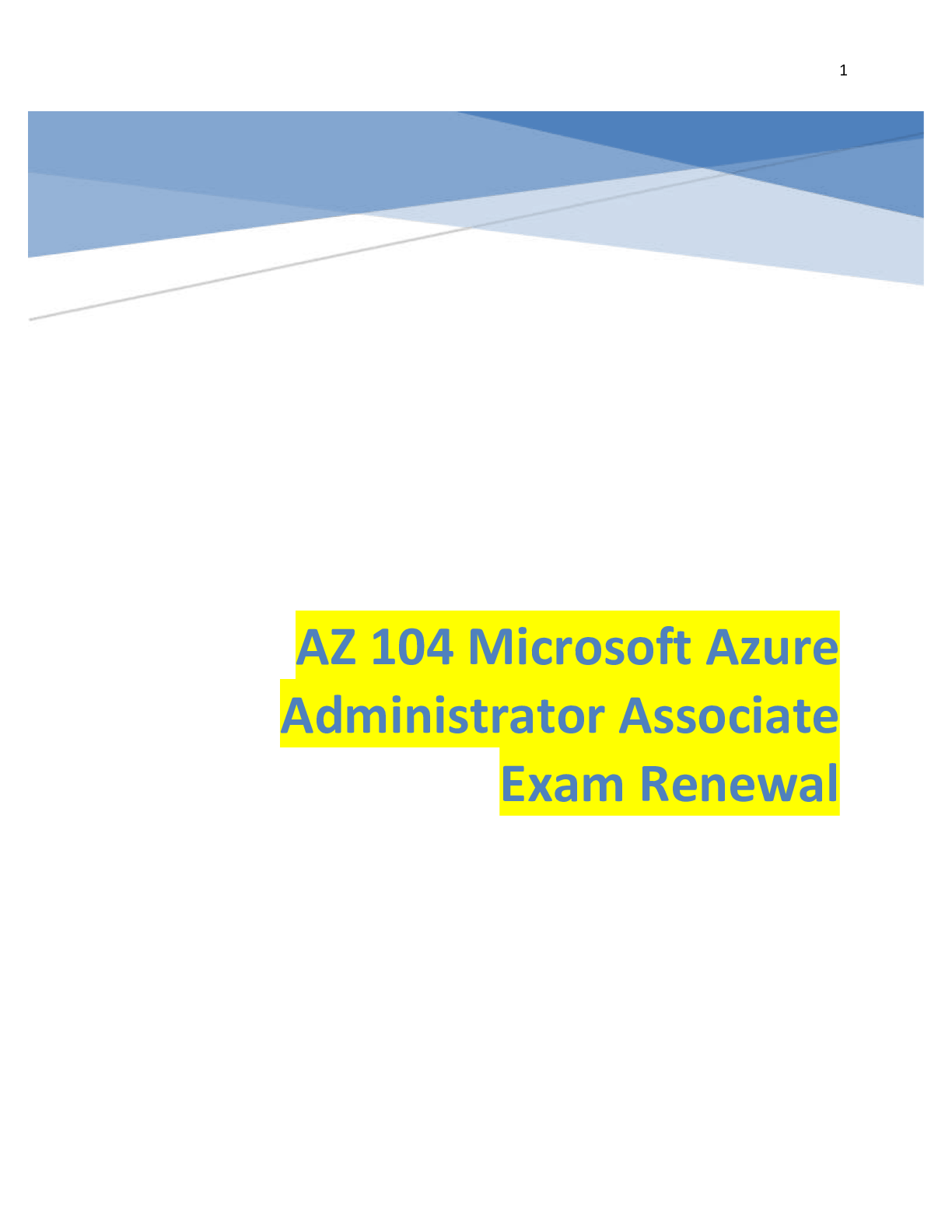
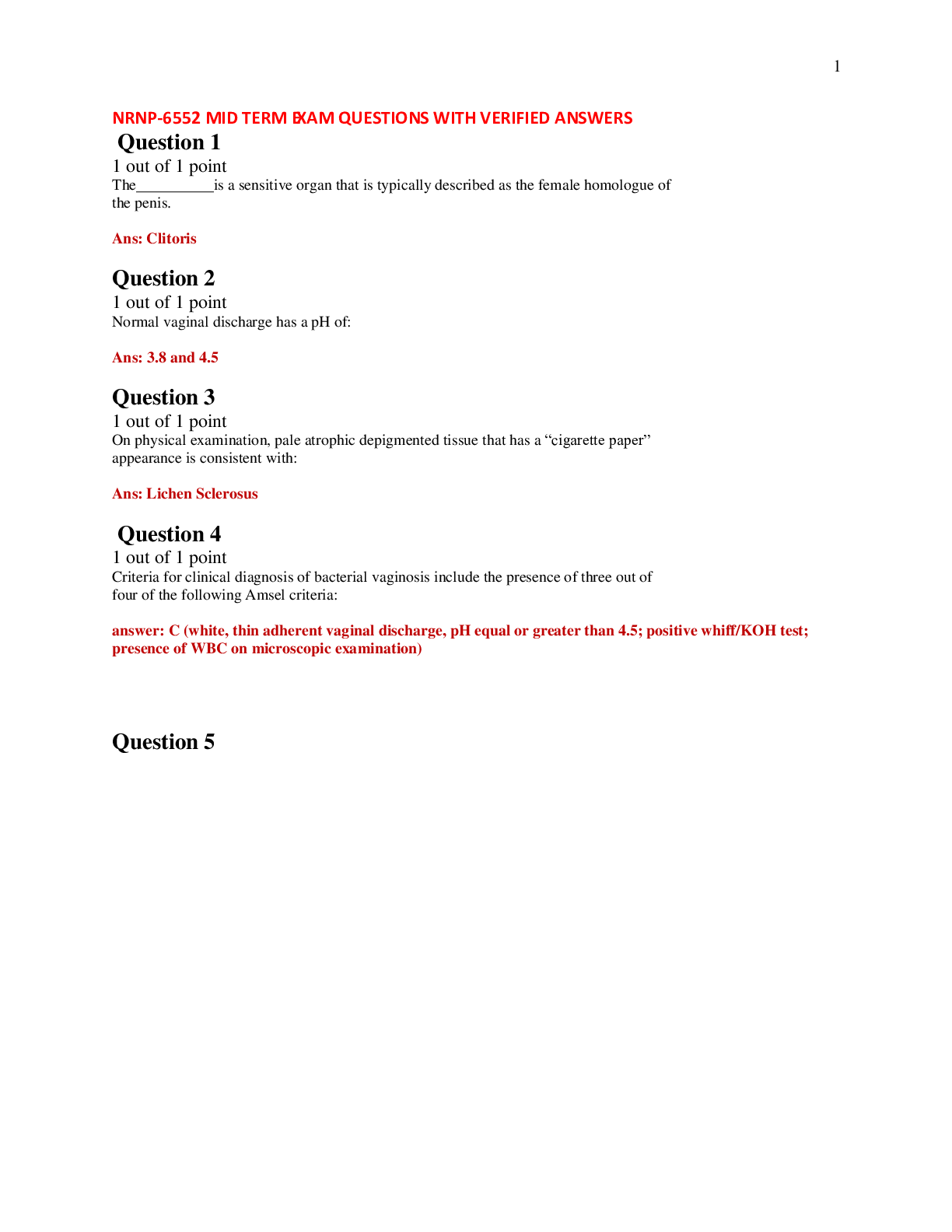
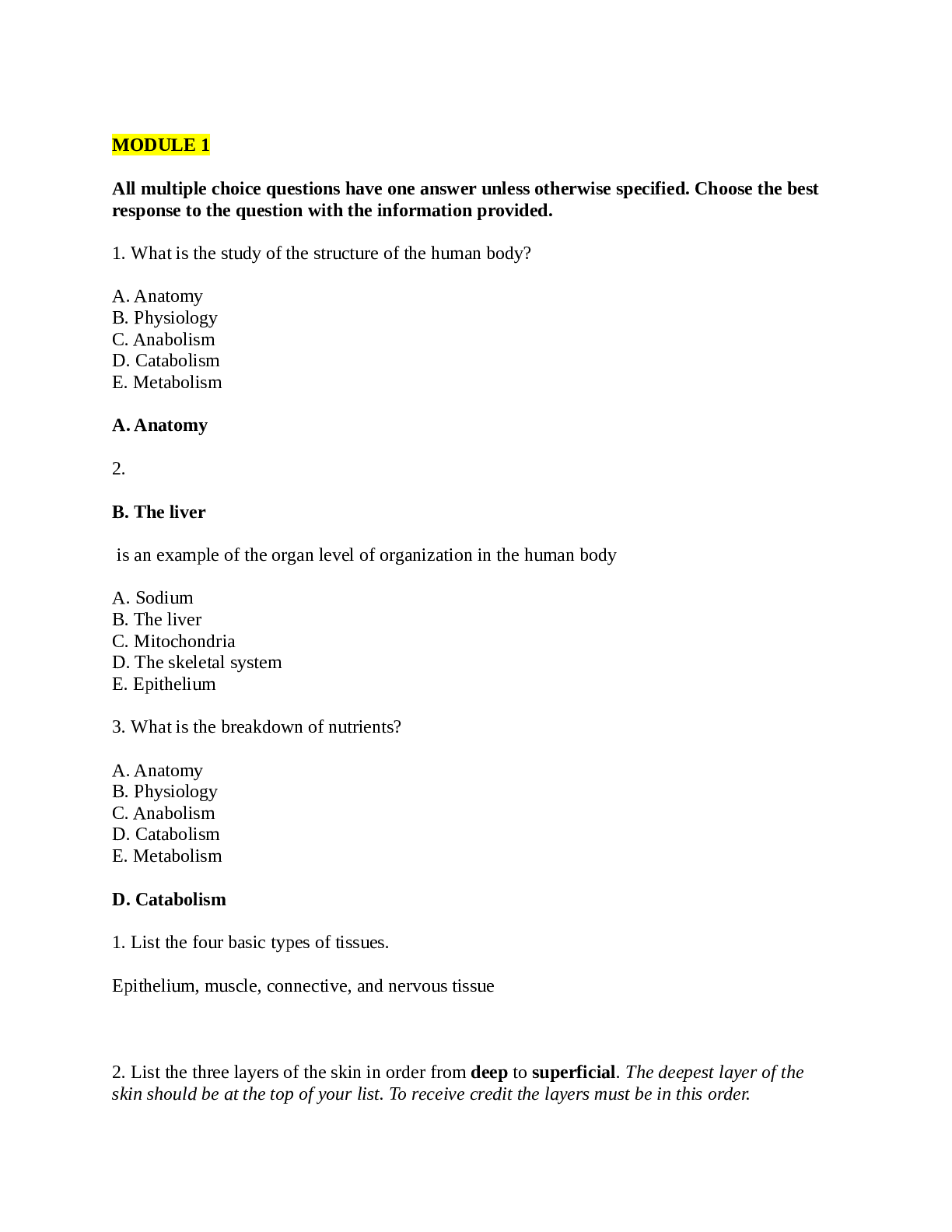

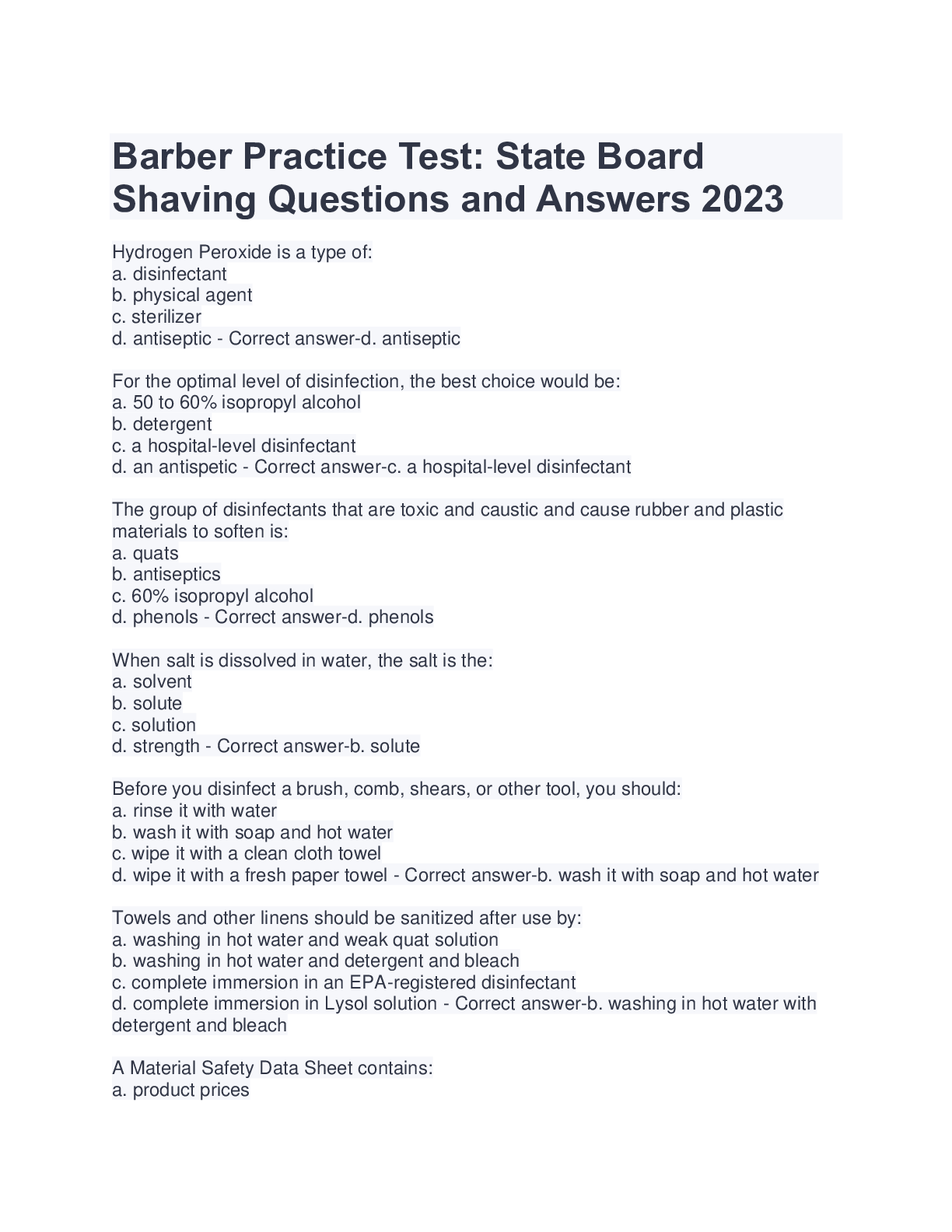
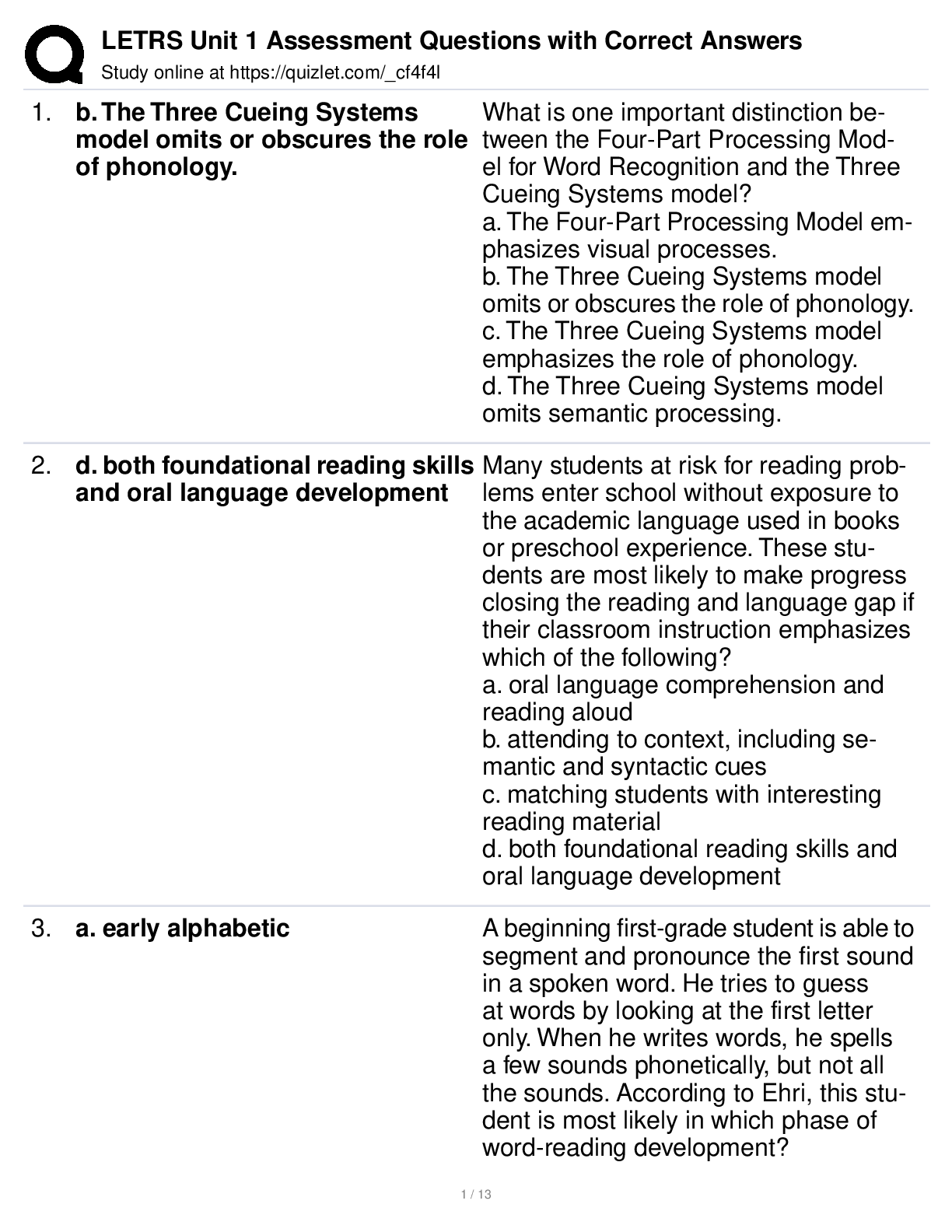


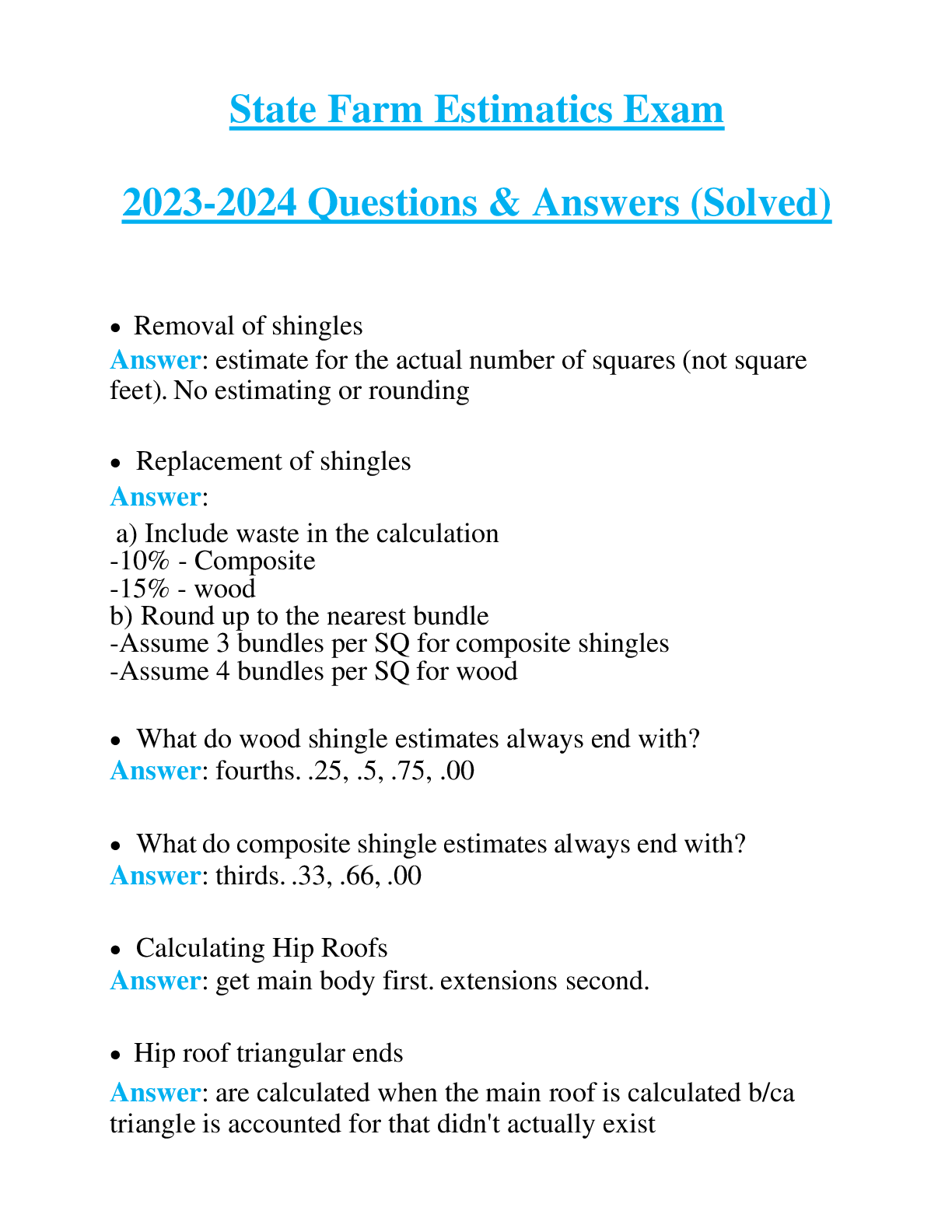
.png)

